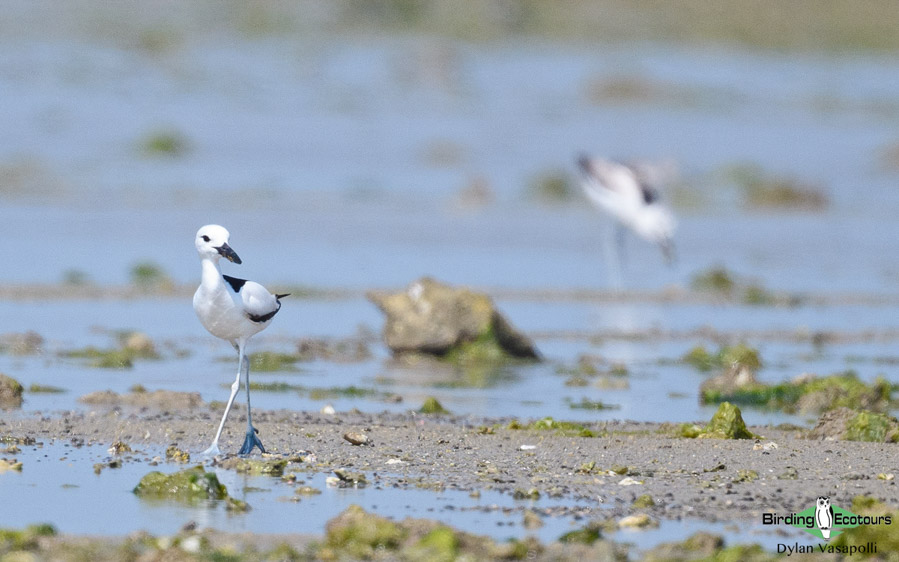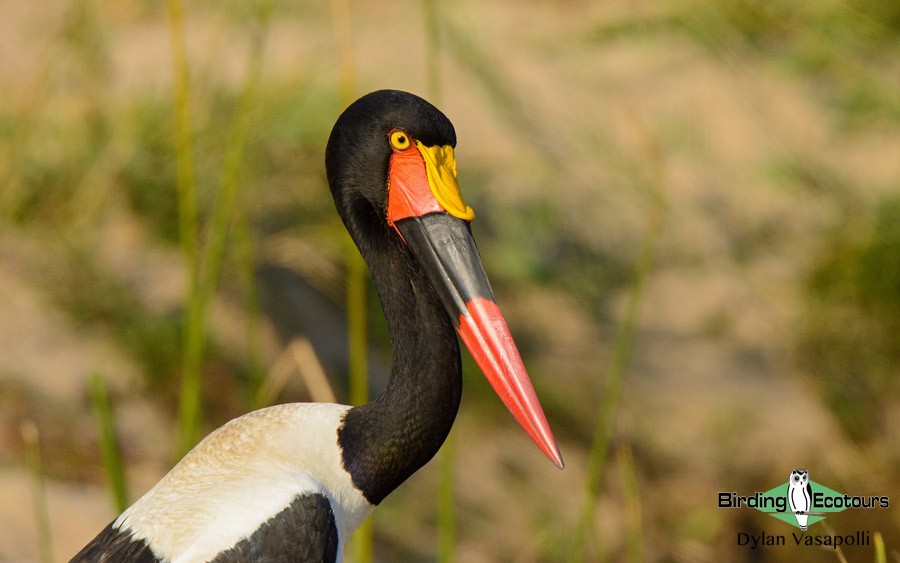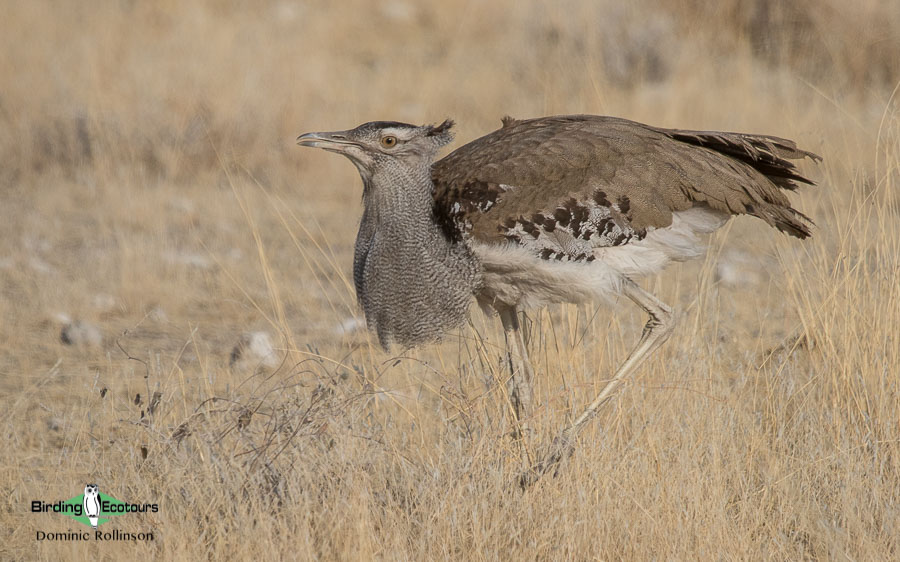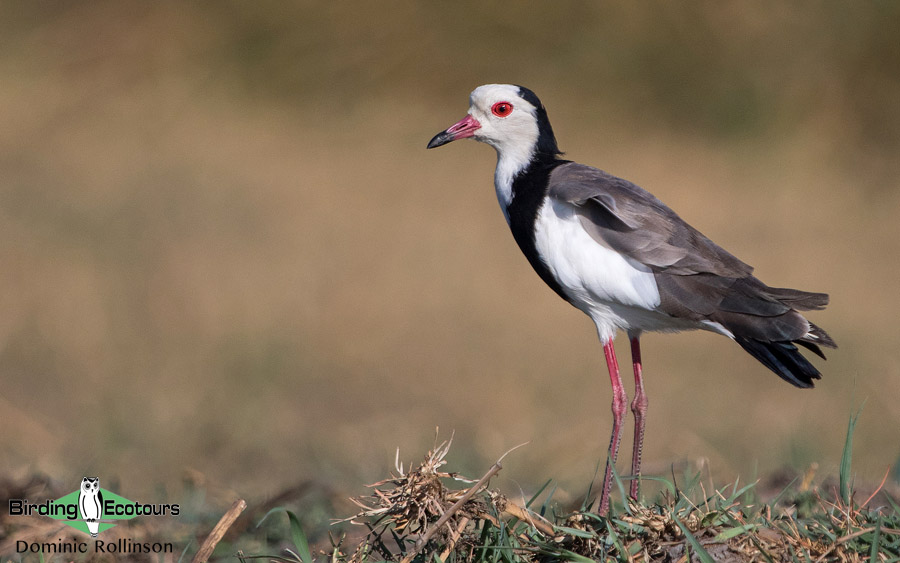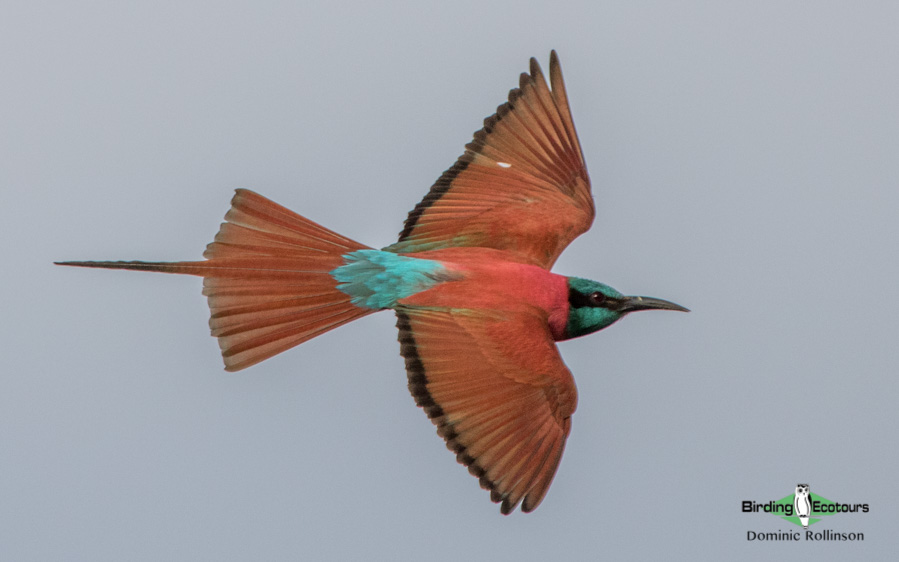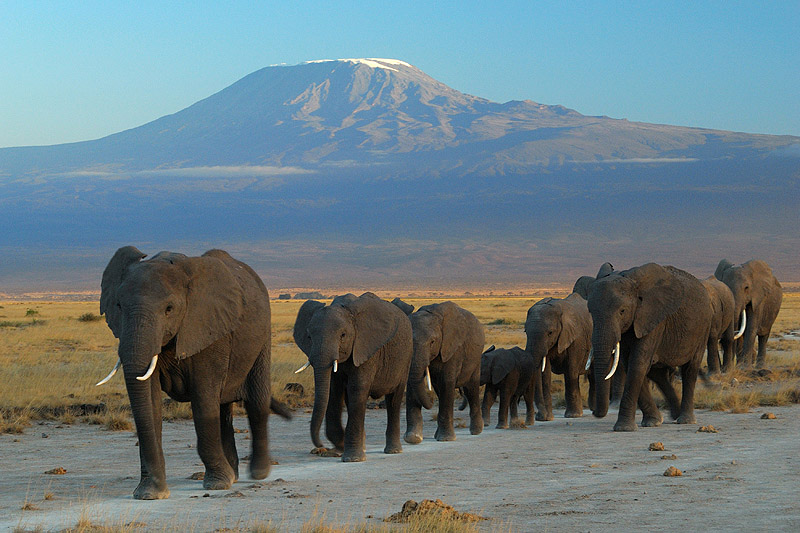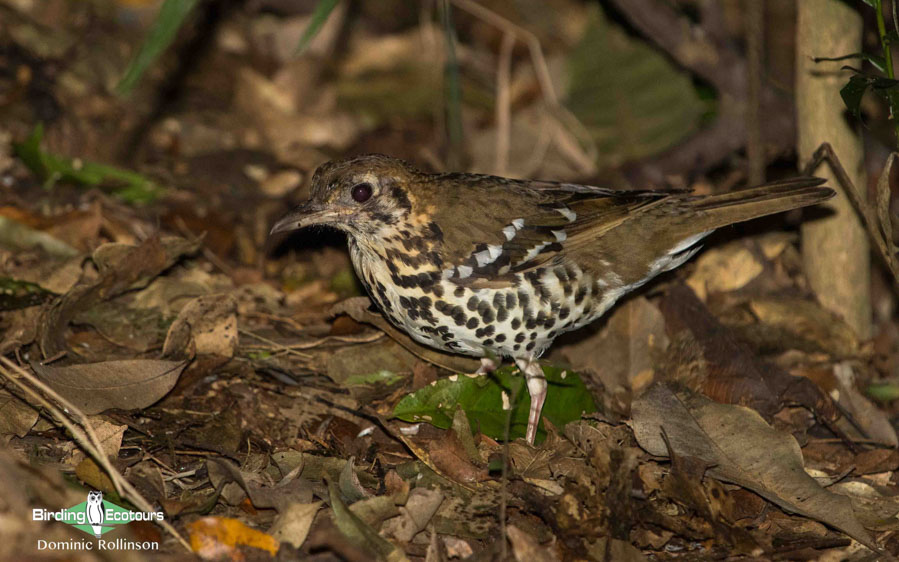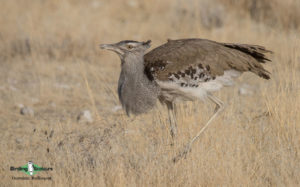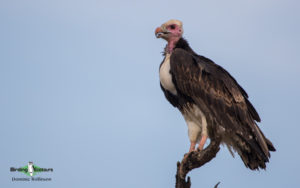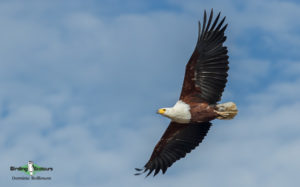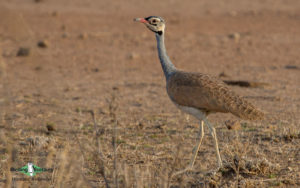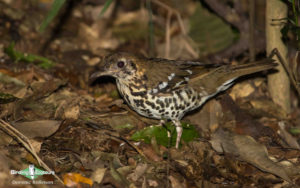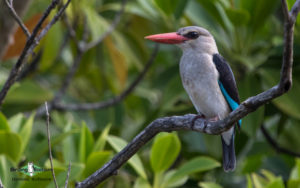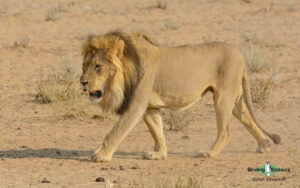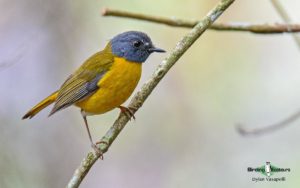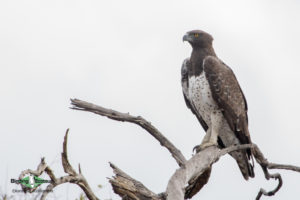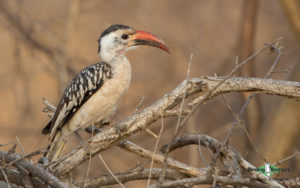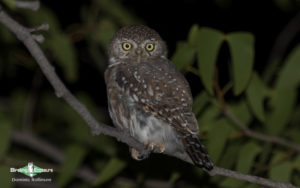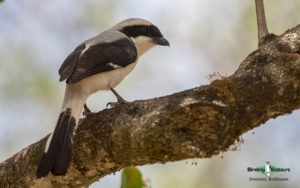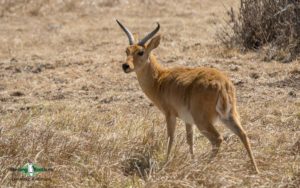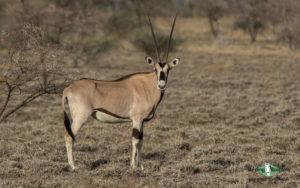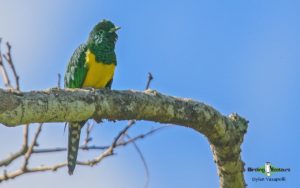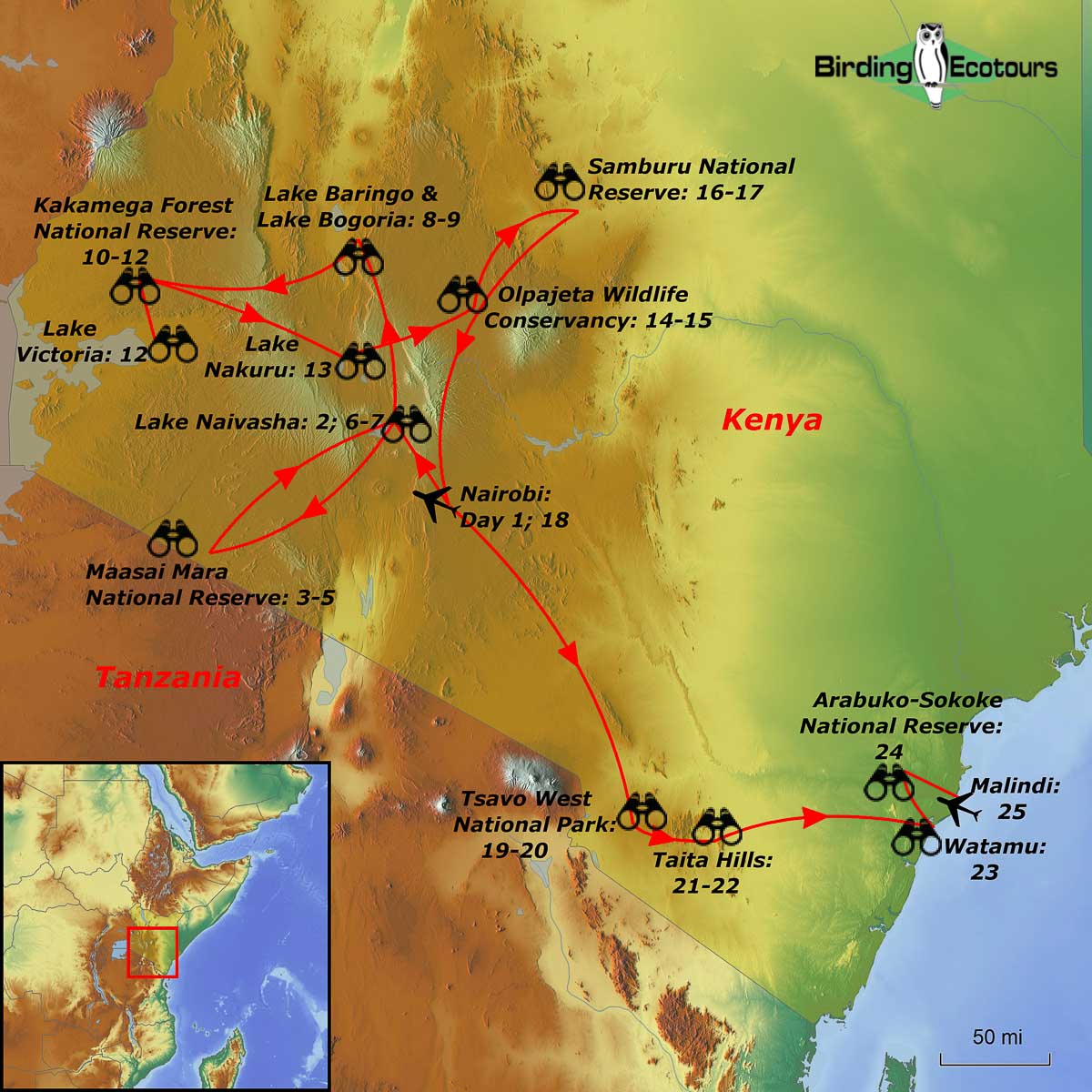Kenya: Comprehensive Premium Birding and Wildlife Safari
Go to: Kenya Birding Tours | Birding Tours in Africa | All our birding tours
Comprehensive Premium Kenya Birding and Wildlife Safari
July 2025
This 25-day birding and wildlife holiday in Kenya is a more comprehensive tour of this staggeringly diverse country than any other birding tour of Kenya that we have been able to find. This trip is also more of a premium trip than most birding tours of this amazingly mammal- and bird-rich country; we use relatively spacious vehicles and comfortable accommodation compared to a number of other Kenya birdwatching holidays we’ve seen offered.
The iconic Secretarybird should be seen on this tour.
Kenya has a spectacularly diverse array of habitats packed into a small area. These range from humid tropical lowland forests with localized denizens such as Sokoke Scops Owl near the idyllic Indian Ocean coastline (which boasts Crab-plover), to snow-capped mountains at over 16,000 feet (5,000 meters) above sea level! In between the sea and the high mountains are vast arid savannas and grasslands that are famous for their endless herds of wildlife, opportunistic predators such as Africa’s big cats, and a myriad of colorful bird species. Then there are the Great Rift Valley scarps and flamingo-filled lakes, highland grasslands, the Taita Hills, a staggeringly bird-diverse tropical rainforest in the form of Kakamega and last but not least the papyrus-lined Lake Victoria, the continent’s biggest lake.
We may be lucky enough to encounter Crab-plover along the Indian Ocean coastline.
Kenya is smaller than Texas, yet boasts an incredible 1,162 bird species. A relatively modest eleven of these species are single country endemics, but then Kenya also boasts a range of East African endemics such as a number of species only occurring in Kenya and Tanzania. The country has 62 Important Bird Areas (IBAs) and some of the most famous game parks in the world, including the Maasai Mara and its endless migrating wildebeest herds, Amboseli with Mount Kilimanjaro as a backdrop, and many others.
This comprehensive wildlife and birding vacation to Kenya should enable you to see around 600 bird species, enjoy excellent large game viewing and allow you to see some of Africa’s most famous sites. While we enjoy all the wildlife, we are sure to spend adequate time looking for the localized bird specials of Kenya (and East Africa as a whole), including Hinde’s Babbler, the Taita Hills endemics, Turner’s Eremomela, papyrus swamp endemics, some breathtakingly beautiful turacos, Grey-crested Helmetshrike, Abbott’s Starling, Sharpe’s Longclaw and a great variety of others.
Itinerary (25 days/24 nights)
Day 1. Nairobi
Upon arrival at the Jomo Kenyatta International Airport (JKIA) in Nairobi you will be met by our driver and tour leader and transferred to your hotel. If you arrive early, there might be time to visit the excellent Nairobi National Park. Here, Africa’s big game species (along with smaller animals such as Thomson’s Gazelle) can be seen right on the outskirts of Kenya’s capital. It’s also a rhino sanctuary and an Important Bird Area (IBA). We hope to get our bird list off to a good start with species like Saddle-billed Stork, Yellow-throated Sandgrouse, Martial Eagle (Africa’s largest eagle), Rüppell’s Vulture, Eastern Chanting Goshawk, Common Ostrich, Hartlaub’s Bustard and the East African endemic Red-throated Tit.
The impressive Saddle-billed Stork should be seen on this tour.
Near Nairobi is also the Kikuyu Escarpment at the foot of the Aberdare Mountains. Both are IBAs with important Afrotropical highland montane species including Abbott’s Starling, Black-fronted Bushshrike, Aberdare and Hunter’s Cisticolas, Kikuyu White-eye, Grey Cuckooshrike, Chestnut-throated Apalis, Grey Apalis, Mountain Greenbul and White-starred Robin, among many others.
Overnight: Nairobi
Day 2. Gatamaiyu Forest, Kikuyu Escarpment and the Kinangop Plateau Grasslands.
This morning we travel to Gatamaiyu Forest, part of the chain of forest fragments that form the Kikuyu Escarpment Forest about 37 miles (59 kilometers) north-west of Nairobi. This is a tropical montane forest at the foot of the Aberdare range. The forest covers close to 12,000 acres (4,720 hectares). Here, we will look for the Vulnerable (IUCN) Abbott’s Starling in the forest canopy, a denizen of a few Afromontane forests in East Africa. We will also look for other range-restricted species such as Jackson’s Spurfowl and Hunter’s Cisticola. With luck we may find Rufous-breasted Sparrowhawk and Africa’s heaviest and most powerful (but not biggest) eagle, Crowned Eagle. Other species we hope to get acquainted with here are African Hill Babbler, White-starred Robin, Silvery-cheeked Hornbill, Tambourine Dove, Mountain Greenbul, the gorgeous and personality-filled Hartlaub’s Turaco, Slender-billed Greenbul and Kikuyu White-eye among many others. We plan to finish our birding here in the late morning before rewarding ourselves with a picnic lunch.
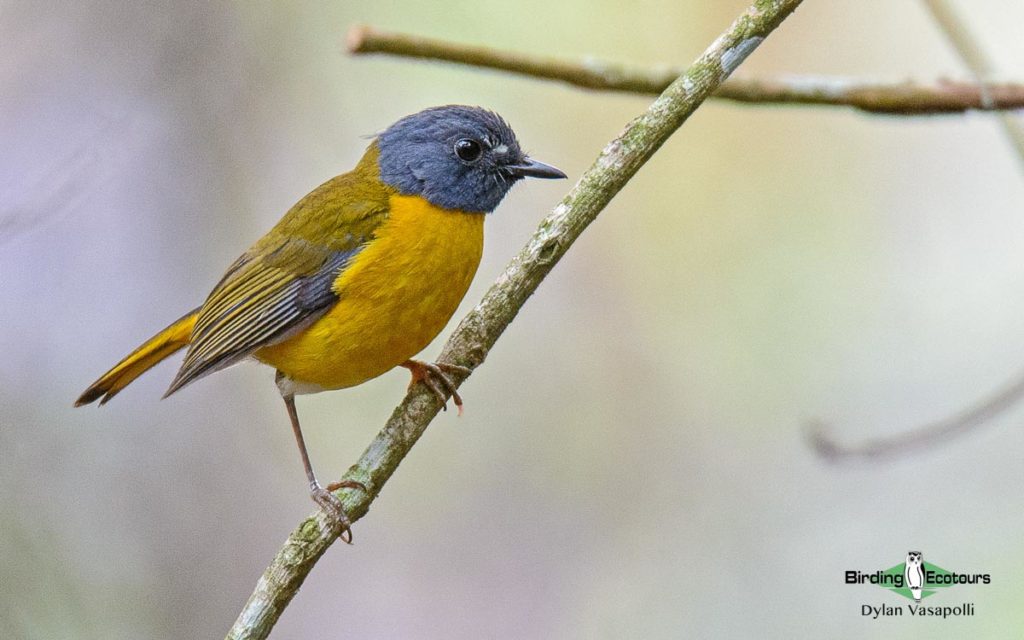
After lunch, we proceed to the Kinangop Plateau grasslands (another IBA) still on the slopes of the Aberdare Range. A major target here is Kenya’s well-known grassland endemic, the Endangered (IUCN) Sharpe’s Longclaw. Many more common and widespread African birds should also be seen here including Black-winged Lapwing, Wing-snapping Cisticola, Long-tailed and Jackson’s Widowbirds, and Nyanza Swift.
Overnight: Naivasha
Day 3. Naivasha to Maasai Mara National Reserve
This morning, we’ll depart for the famed Maasai Mara National Reserve, contiguous with the Serengeti just across the border in Tanzania. The drive will already present some special rewards, like a sudden surprising, stunning outlook from a viewpoint at the top of the escarpment over the width of the Great Rift Valley, with Rock Hyraxes also enjoying the view. All kinds of spectacular birds along with large (and small!) game animals abound, including Grey Crowned Crane, Secretarybird, Common Wildebeest, Thomson’s Gazelle, Plains Zebra, Impala, Black-backed Jackal, Common Duiker, Vervet Monkey, and even (Maasai) Giraffe – roaming freely in the fields and using the roads together with the traffic, long before we even enter any game reserve.
The massive Kori Bustard is often seen strolling across the open plains.
We’ll arrive in time for lunch and take an afternoon game drive for some of the big game animals and local birds like Kori Bustard (the world’s heaviest flying bird), several of the seven species of vultures here including Egyptian, Hooded, Rüppell’s, Lappet-faced, and White-headed, Secretarybird, Coqui Francolin, Von der Decken’s Hornbill, Hildebrandt’s Starling and Silverbird.
Overnight: Sarova Mara Lodge, Maasai Mara National Reserve
Day 4. Maasai Mara National Reserve
We will have a full day of birding in the park with a picnic lunch. We’ll visit the Mara River, hoping to see part of the great wildebeest migration crossing the river, but this can of course not be guaranteed (the timing varies from year to year). We’ll also look out for the “big five”: African Elephant, Lion, Leopard, rhinoceros, and African Buffalo. We should also see Hippopotamus and plains game like Thomson’s Gazelle, Topi, (Maasai) Giraffe, and Black-backed Jackal.
Birds we expect to see here include Red-necked Spurfowl, White-bellied and Black-bellied Bustards, a number of vulture species, plus many other raptors like the beautiful Long-crested Eagle, the gigantic Martial Eagle, Tawny Eagle, Wahlberg’s Eagle, Black-chested Snake Eagle, the colorful Bateleur (one of the most beautiful eagles!), Shikra, and African Goshawk. In the more open areas, we can expect to encounter several species of colorful Bee-eaters, such as Cinnamon-chested, Little and White-throated, Kingfishers such as Grey-headed and African Pygmy and Rollers such as Purple and Lilac-breasted. The grasslands and woodlands also hold species such as Coqui and Red-winged Francolins, Pygmy Falcon, Southern Ground Hornbill, Fischer’s Sparrow-Lark, Foxy Lark, Trilling Cisticola, and many others.
Overnight: Serena Lodge, Mara Triangle
Day 5. Maasai Mara National Reserve
We can have a pre-breakfast cup of coffee and tea before our early morning game drive, after which we will return to our lodge for a proper sit-down breakfast. It is our last day in Mara, so we will carry a picnic lunch and stay out the rest of the day looking for different wildlife (as mentioned above). We also hope to enjoy large herds of wildebeest (it will be the start of the migration season) and will look out for possible wildebeest river crossing sites.
Overnight: Serena Lodge, Mara Triangle
Day 6. Maasai Mara to Lake Naivasha
After breakfast, we depart for Lake Naivasha, arriving in time for lunch. Lake Naivasha is a birdwatcher’s paradise with over 200 species having been recorded from the area. Our afternoon birding may yield Tropical Boubou, Orange-breasted Bushshrike, White-headed Barbet, Variable Sunbird, the dazzling Purple Grenadier, White-browed Robin-Chat with its beautiful song, the arid country specialist Buff-bellied Warbler, and Red-faced Crombec. Along the edge of the lake, we hope to find Yellow-billed Stork, Long-toed and Spur-winged Lapwings, Malachite Kingfisher, and Pink-backed Pelicans.
Overnight: Naivasha
Day 7. Lake Naivasha, Crescent Island Game Park
We will wake up early and do some pre-breakfast birding. After breakfast we’ll head for Crescent Island, a private wildlife game sanctuary on the eastern side of Lake Naivasha. It was created in 1988, and following a sudden drop in water levels in 2000, Crescent Island became part of the mainland and is now a peninsula. Big game animals, including Plains Zebra, Thomson’s Gazelle, Impala, and (Maasai) Giraffe, can all usually be seen up-close. Other wildlife includes (Defassa) Waterbuck, Common Eland and Common Wildebeest.
The strikingly colored Long-toed Lapwing can be seen at Lake Naivasha.
Up to 80 waterbird species have been recorded during censuses, including White-backed Duck, Saddle-billed Stork, Marabou Stork, African Spoonbill, Great Crested Grebe, the ubiquitous but attractive African Jacana, and various striking lapwing species such as Long-toed and Spur-winged Lapwings.
We also hope to find the localized, Near Threatened (IUCN) Grey-crested Helmetshrike, the personality-filled Grey-capped Warbler, White-bellied Tit and a wide variety of more widespread terrestrial birds such as Black-headed Oriole, Red-chested Cuckoo, Pearl-spotted Owlet, Grey-backed and Northern Fiscals, along with many others (in Kenya, there are birds everywhere, and just so many different species!).
Overnight: Naivasha
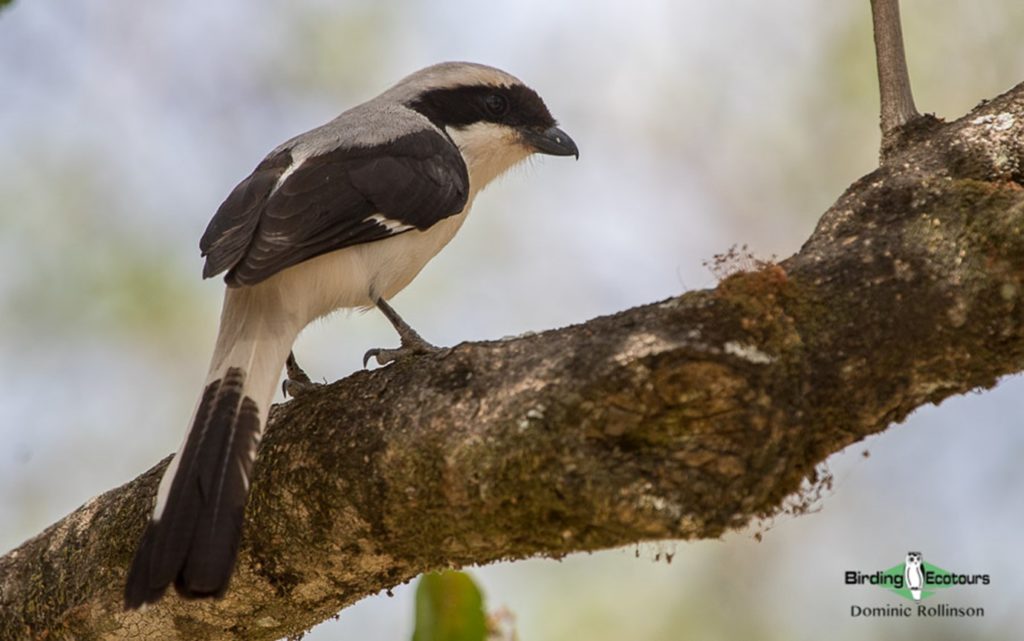
Day 8. Lake Naivasha to Lake Bogoria National Reserve
After an early breakfast, we will check out and depart towards the wonderful Lake Bogoria National Reserve, planning to arrive at Lake Bogoria Spa Lodge in time for lunch. After lunch, we will drive to the Lake Bogoria National Reserve. Unlike Lake Nakuru, whose salinity level has been affected by an increased water volume, Bogoria’s water salinity has not been affected. Hence, the lake has retained the spirulina (blue-green algae) which is the food of Lesser Flamingo and we hope to see large numbers here (they have vanished from Lake Nakuru because of rising water levels). We might also see Greater Flamingo, Black-necked Grebe, Steppe Eagle, Tawny Eagle, African Fish Eagle and as usual a host of other interesting species in the nearby woodlands such as Pygmy Batis, Slate-colored Boubou, Nubian Woodpecker and Red-fronted Barbet.
Overnight: Lake Bogoria Spa (we’ve had to tweak our itinerary in recent years because of flooding of the rift valley lakes and two hotels being submerged!).
Day 9. Lake Baringo National Reserve: cliff specialists, boat ride and more
After breakfast we head to Lake Baringo early in the morning. We arrive and meet our coxswain ready to take us birding by motor boat. Unlike Lake Bogoria, just a few miles away, Lake Baringo is a freshwater lake which means a different mix of waterbirds. Some of the birds we expect to see here include Goliath Heron, Hamerkop, Senegal Thick-knee, Gull-billed Tern, Grey-headed Kingfisher, dazzling Northern Carmine Bee-eater, and Golden-backed Weaver, among others.
The vivid colors of Northern Carmine Bee-eater will leave you awestruck.
After a two-hour boat ride, we have an hour or so to search for terrestrial beauties here like Eastern Violet-backed Sunbird, Spotted Palm Thrush and Abyssinian Roller among others, before we break for lunch. In the late afternoon we resume birding, now along the cliffs, looking for Hemprich’s Hornbill, Bristle-crowned Starling, Verreaux’s Eagle, and Rock Hyrax, the eagle’s main prey. With the help of a local naturalist, we’ll walk along the famous Tugen Hills, known for their great diversity of raptors and owls, as well as interesting passerines. Here we hope to find Three-banded Courser, Slender-tailed Nightjar, Greyish Eagle-Owl, Verreaux’s Eagle-Owl, Pearl-spotted Owlet, Lichtenstein’s Sandgrouse, White-bellied Canary, Brown-tailed Rock Chat, Jackson’s Hornbill, Speckle-fronted Weaver, White-billed and White-headed Buffalo Weavers, Dark Chanting Goshawk, African Grey and Nubian Woodpeckers, Red-and-yellow and D’Arnaud’s Barbets, and Purple Roller, and many others.
Overnight: Lake Bogoria Spa
Day 10. Lake Baringo to Kakamega Forest National Reserve
We’ll do a pre-breakfast bird walk, and after we’ve eaten, we’ll drive to the Kakamega Forest National Reserve. This drive takes us through the beautiful scenery of the Kerio Valley. We will stop in the valley for a picnic lunch and do some birding, looking for White-crested Turaco, Beautiful Sunbird, Orange-breasted and Grey-headed Bushshrikes, and White-crested Helmetshrike, among others.
Kakamega Forest is Kenya’s only true tropical rainforest, similar to the central and west African forests, and this area is alive with birds, some of which are found nowhere else in the country. We will also have a full day tomorrow to explore this bird-rich area.
Overnight: Rondo Retreat Center, Kakamega Forest
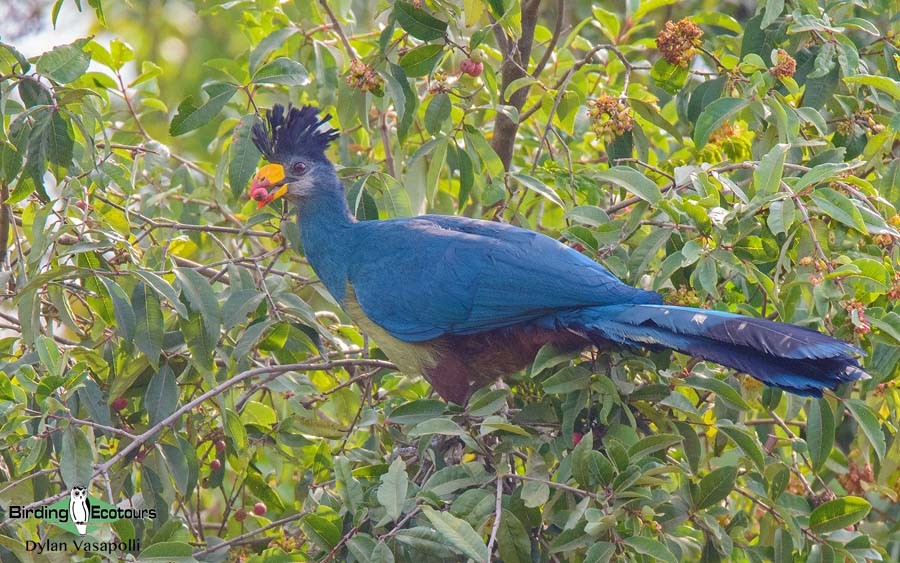
Day 11. Kakamega Forest National Reserve
We will spend the day enjoying the sights and sounds of this unique forest. We’ll walk the numerous forest trails here in search of many of Kakamega’s 194 bird species. The forest is West African in character, and many birds’ Kenyan distributions are confined to this forest, here at the eastern extent of their range only marginally making it into this country. The rainforest is also a haven for butterflies and other insects, along with its vast avian riches.
In this tropical greenhouse we’ll get a chance to see Great Blue Turaco, Blue-headed Bee-eater, Brown-eared Woodpecker, Yellow-crested Woodpecker, Buff-spotted Woodpecker, Joyful Greenbul, Shelley’s Greenbul, Red-tailed Bristlebill, Cabanis’s Greenbul, Slender-billed Greenbul, the gem-like African Emerald Cuckoo, and the cacophonous Black-and-white-casqued Hornbill. The forest is well-known for scarce/localized forest barbets including the stunning Yellow-billed Barbet. The forest has a Near-Threatened (IUCN) high canopy warbler species, Turner’s Eremomela, which we will scan for in canopy bird parties. The area also has a small population of the Endangered (IUCN) Grey Parrot, a species which, with some luck, we can find here (although it is much easier on our West African tours, such as to Ghana).
Kakamega Forest also supports good populations of three species of wattle-eyes including Yellow-bellied, Jameson’s and Chestnut Wattle-eye. The shy White-spotted Flufftail is sometimes seen along streams near Rondo Lodge. The forest here is dense and pristine with tall tree canopies, where species like Western Oriole, Red-headed Malimbe, Stuhlmann’s Starling, Sharpe’s Drongo and many others can be searched for.
A range of primate species such as Blue and Red-tailed Monkeys, beautiful Guereza (Black-and-white Colobus), as well as De Brazza’s Monkey, can also be seen in this forest. Forty percent of the total butterfly population of Kenya is found in Kakamega Forest as well. We’ll also get a chance to experience more of the diverse African culture of the Luhya people.
Overnight: Rondo Retreat Center, Kakamega Forest
Day 12 Birding on the shores of Lake Victoria
We will start the day with an early breakfast and then have a one-hour transfer south to the shores of Lake Victoria. This is Africa’s largest freshwater body and in fact the second-largest freshwater lake in the world. The lake borders three East African countries, Kenya, Uganda and Tanzania, most of it being in Tanzania (49%) and Uganda (45%), with Kenya having the smallest portion (6%). It is the source of the mighty Nile River flowing north to Egypt. The reed beds around the lake provide unique habitat for a few papyrus specials including Papyrus Gonolek, Papyrus Canary and Carruthers’s Cisticola. Also present here are many strikingly-colored weavers such as Black-headed Weaver, Northern Brown-throated Weaver and Slender-billed Weaver. We aim to arrive here around 8 am and will then team up with our local guide and coxswain for a boat ride on the lake looking for the abovementioned species. After a few hours on the lake, we will enjoy coffee and a cup of tea and then head back to Rondo Retreat for lunch. We will then enjoy our last birding around the forest in the late afternoon.
Overnight: Rondo Retreat Center, Kakamega Forest
Day 13. Kakamega Forest National Reserve to Lake Nakuru National Park
We’ll depart, after breakfast, for Lake Nakuru National Park, allowing time to search for several key species along the way. In the early afternoon we’ll arrive at Lake Nakuru National Park, where in previous years, vast numbers of Lesser Flamingos used to feed in the shallow alkaline water, now replaced with smaller numbers of Greater Flamingos because of a change in the lake’s salinity. Lake Nakuru National Park was recently named an IBA by BirdLife International due to the huge bird populations/diversity in this magnificent park. A large rocky escarpment en route is a favorite roosting spot for Mackinder’s Eagle-Owl, the northern subspecies (sometimes split into its own species) of Cape Eagle-Owl. The Acacia scrub is a favorite haunt for Little Rock Thrush, Mocking Cliff Chat, Pale Flycatcher and Purple Grenadier. Exploring the Acacia woodland and lakeside marshes we will no doubt come across many other wonderful avian delights in addition, such as Great White Pelican, African Harrier-Hawk, Hildebrandt’s Spurfowl, Levaillant’s Cuckoo, White-browed Coucal, Green Wood Hoopoe, Red-throated Wryneck, African Grey Woodpecker, Anteater Chat, Grey-backed Fiscal, Brown-crowned Tchagra, Fischer’s Lovebird and African Firefinch.
Mammals are also quite common in the park, and this is one of the few places in East Africa where both the endangered White and Black Rhinoceroses can be found. Some of the other mammals we hope to encounter are (Rothschild’s) Giraffe and Bohor Reedbuck.
Overnight: Nakuru
Day 14. Lake Nakuru National Park to Ol Pejeta Wildlife Conservancy
We’ll depart, after breakfast, for Ol Pejeta Wildlife Conservancy, allowing time to search for several key species along the way. We will also have a stopover at Thomson’s Falls at Nyahururu which is one of Kenya’s highest towns, at 7,700 feet (2,360 meters) above sea level. Just outside the town lies Thomson’s Falls on the Ewaso Narok River. It falls an impressive 230 feet (72 meters), with the mist feeding the dense forest below. At Thomson’s Falls we’re likely to see Chestnut-winged and Slender-billed Starlings, Rock Martin, Grey Cuckooshrike, Kikuyu White-eye, and Tacazze and Collared Sunbirds. We will have our lunch here before proceeding to Ol Pejeta, however we will have a stop en route at Wajee Camp to look for the Vulnerable (IUCN) Kenyan endemic Hinde’s Babbler as well as Holub’s Golden Weaver.
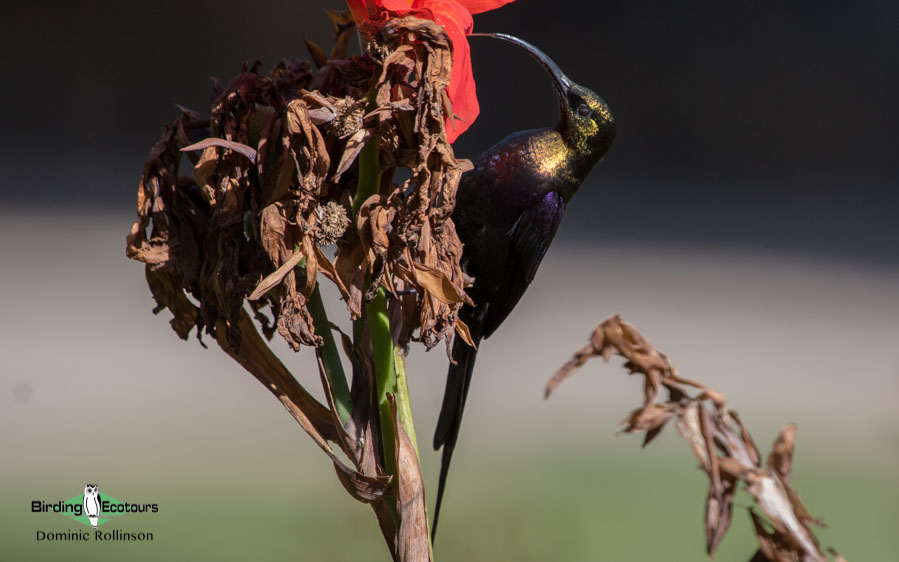
In the afternoon we will arrive at Ol Pejeta Wildlife Conservancy and head straight to the lodge. Later in the afternoon we will enjoy yet another fantastic game drive looking for both Black and White Rhino, while other wildlife here includes African Elephant, African Buffalo, Grevy’s Zebra, Bushbuck, and Common Warthog. We may take a walk in the nearby forest, where we’ll look for African Dusky Flycatcher, Cabanis’s Greenbul, Abyssinian Thrush and others.
Overnight: Serena Camp, Ol Pejeta Wildlife Conservancy
Day 15. Ol Pejeta Wildlife Conservancy
On our second day here, we will have an early-morning game drive (before breakfast), looking for both Red-billed and Yellow-billed Oxpeckers, Fischer’s Sparrow-Lark, Northern White-crowned Shrike, Meyer’s Parrot and Augur Buzzard and lots more. After breakfast we can visit the Chimpanzee Sanctuary and learn more about this fascinating primate, whose population in the wild is heavily affected by poaching and illegal trafficking. We will then have lunch at our lodge and enjoy an early-afternoon rest before our late-afternoon game drive.
Overnight: Serena Camp, Ol Pejeta Wildlife Conservancy
Day 16 Ol Pejeta Wildlife Conservancy to Samburu National Reserve
In the morning we will take a bird walk around the lodge grounds and then after another tasty breakfast we will depart for Samburu National Reserve. This is one of our longer drives (roughly four hours), however we will take birding stops along the way which will give us the opportunity to stretch our legs and enjoy more of Kenya’s magnificent birdlife. In particular we will keep our eyes open here for spectacular Long-tailed and Red-collared Widowbirds along the roadside.
Samburu is an arid reserve, presenting us with some new species as described for the next day. Our hosts here are the Samburu people, who are pastoralists, herding their cattle like their cousins in the south, the Maasai. We will search for game animals as we make our way to our lodge and will have a chance for an evening game drive in search of the many birds and animals that inhabit this impressive park.
Overnight: Samburu National Reserve
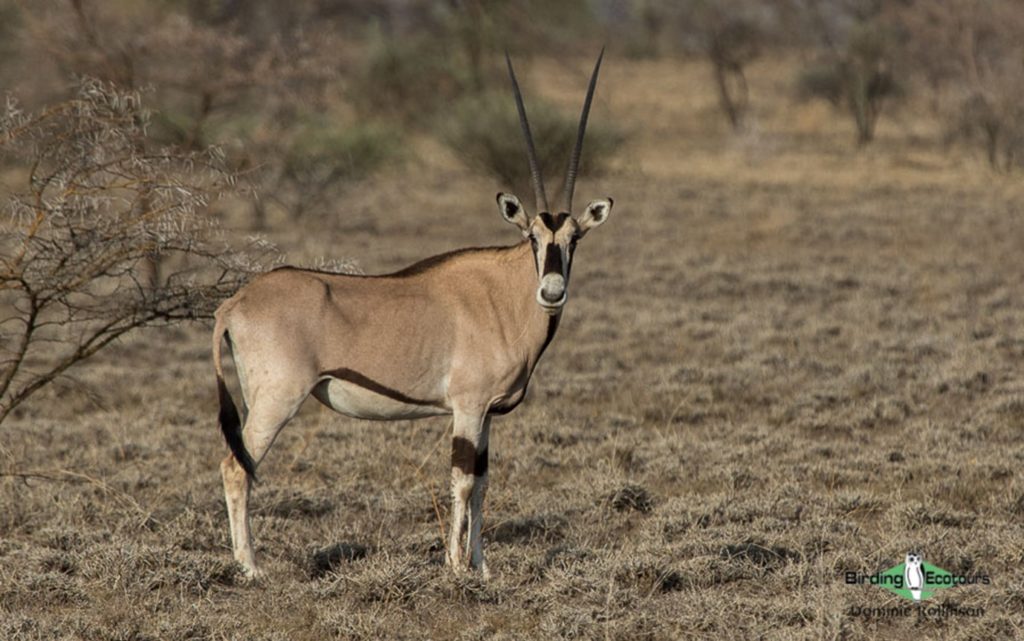
Day 17. Samburu National Reserve
Samburu is one of the most exciting reserves in Kenya, perhaps even in greater East Africa, with the semi-desert habitat and rich woodlands along the Ewaso Ng’iro River teeming with wildlife. Exploring this fantastic reserve will always produce a most overwhelming array of bird species, such as Somali Ostrich, African Hawk-Eagle, Crested Francolin, Yellow-necked Spurfowl, impressive Vulturine Guineafowl, Kori, Buff-crested and White-bellied Bustards, Black-faced and Lichtenstein’s Sandgrouse, Red-bellied Parrot, Somali Bee-eater, Von der Decken’s Hornbill, stunning Red-and-yellow Barbet, Pink-breasted Lark, truly beautiful Rosy-patched Bushshrike, Hunter’s and Black-bellied Sunbirds, Golden-breasted and Fischer’s Starlings, Donaldson Smith’s Sparrow-Weaver, and Cut-throat Finch. Also found here is the cute White-headed Mousebird, to complete the set of all three Kenyan mousebird species (mousebirds are a charismatic, uniquely African family of wonderfully long-tailed, crested birds), among many other Maasai-Somali biome species.
Mammal life here is also prolific, with many species not seen elsewhere on our tour. Just a few of the many possibilities include Olive Baboon, Dwarf Mongoose, Grevy’s Zebra, Giraffe (Maasai and Reticulated subspecies), Kirk’s and Guenther’s Dik-dik, (Coke’s) Hartebeest, Waterbuck, Gerenuk, Grant’s and Thomson’s Gazelle and the splendid Beisa Oryx.
Overnight: Samburu National Reserve
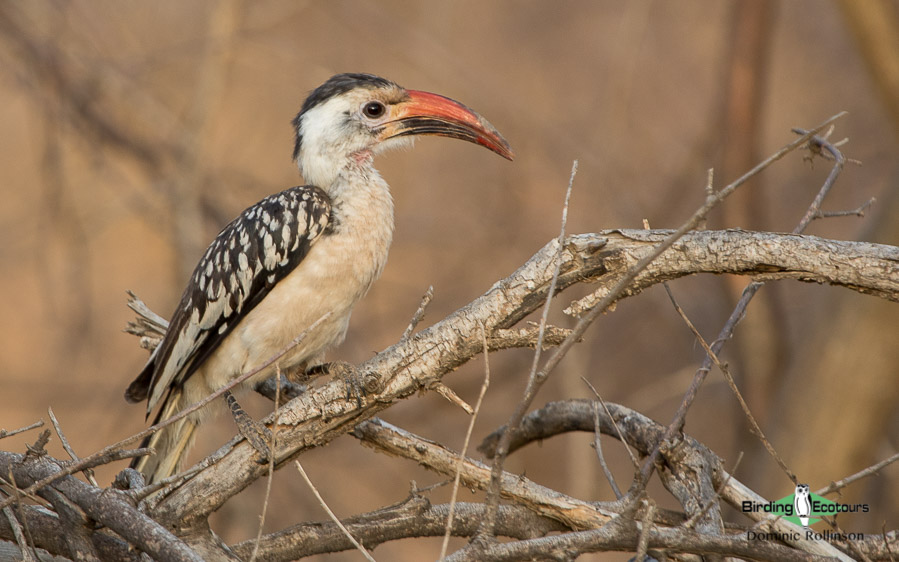
Day 18. Samburu National Reserve to Nairobi
We leave Samburu soon after breakfast and drive southwards towards Nairobi. Birding along the way, we proceed past the semi-arid Northern Frontier District into the Mount Kenya region. En route we will pass through spectacular scenery, with the grasslands along the roadside a great place for Black-winged Lapwing, Black-winged Kite, Dusky Turtle Dove, Cape Crow, Long-tailed Widowbird, and Speke’s Weaver.
After crossing the equator, we enter the Central Kenya Highlands between the Aberdare Range and Mount Kenya. On a clear day we may get glimpses of the snow-capped peaks of the second-highest mountain in Africa, Mount Kenya. Making our way farther south out of the Central Kenya Highlands, we’ll see the pineapple plantations of Thika and many Kikuyu subsistence farms before arriving once more in Nairobi.
Overnight: Nairobi
Day 19. Nairobi to Tsavo West National Park via Amboseli and Kilimanjaro
This is a long driving day with an early start, but it will reward us with some of Africa’s most famous scenery and a set of new birds. After breakfast we’ll proceed to Amboseli National Park right near the Tanzania border. Here, Mount Kilimanjaro is a backdrop to amazing scenes of big game and plentiful birds!
While passing through Amboseli National Park, we will enjoy safari scenes with Mount Kilimanjaro as a majestic backdrop (photo Amoghavarsha via WikiMedia/CC BY-SA 3.0)!
Tsavo West National Park is next on our agenda. The Tsavo habitat is a relatively dense thicket of savanna dominated by Acacia and Camiphora bush with baobabs, grassy plains, riverine woodland, and the Mzima Springs. We’ll ensure we arrive in time for lunch. In the afternoon we will take a game drive in the park, which supports a large number of big game species such as African Elephant, rhino, Lion, huge herds of African Buffalo, and more. Here, Mount Kilimanjaro is a backdrop to the amazing scenes of big game and plentiful birds. There will be a large number of new species for us here, including Splendid and Hildebrandt’s Starlings, Common Ostrich, Hartlaub’s Bustard, Black and Abyssinian Scimitarbills, African Grey and Northern Red-billed Hornbills, while night birds include Donaldson Smith’s and Freckled Nightjars, Pearl-spotted Owlet, and African Wood Owl.
Overnight: Tsavo West National Park
Day 20. Tsavo West National Park
After breakfast we tour the Mzima Springs which are part of the Chyulu Range and are composed of porous volcanic lava rock and ashes, which purifies the water to produce the spring’s sparklingly clear water. We shall drive along lava rocks and explore the spring on foot enjoying views of Nile Crocodile and Hippopotamus and birds such as Holub’s Golden Weaver, Red-headed Weaver, Black-necked Weaver, Shikra, Little Sparrowhawk, Eastern Black-headed Batis, African Golden Oriole, Straw-tailed Whydah, and many others.
Other wildlife to experience here includes Blue Monkey, Yellow Baboon, African Elephant and Klipspringer. We will head back to our lodge for lunch and later in the afternoon we will enjoy a game drive to the rhino sanctuary.
Overnight: Tsavo West National Park
Day 21. Tsavo West National Park to Taita Hills
After breakfast we will drive through Tsavo National Park to Taita Hills Wildlife Sanctuary. This is a private conservancy on the slopes of the Taita Hills. The forest shares botanical similarities with the Usambara Mountains in Tanzania to the south. We will arrive in time for lunch and have an afternoon drive exploring the riverine and savanna thickets and open plains in the conservancy for different species of both birds and mammals. We will look for Black-throated Barbet, Pangani Longclaw, Spotted Palm Thrush, Eastern Violet-backed Sunbird, Red-fronted Prinia and Grey Wren-Warbler, among others.
Overnight: Taita Hills Wildlife Sanctuary
Day 22. Taita Hills Forest
We have an early breakfast before dawn and ascend to the Taita Hills forests, birding in the conservancy en route. The drive will take us about two hours to the top of Ngangao Forest, one of the major forest fragments. We will then meet our local guide and explore the forest. One of our major targets will be Taita Thrush which is found on the forest floor and can be a rather shy species; we will thus need to ensure we keep noise to a minimum! We hope to see the other two Taita endemics (Taita Apalis and Taita White-eye) among the many other highland forest species. Other goodies here include Striped Pipit, Yellow-throated Woodland Warbler, Stripe-cheeked Greenbul, White-starred Robin, Hartlaub’s Turaco and many more. After our forest walk, we will have a picnic lunch and head back to the wildlife sanctuary for an afternoon game drive.
Overnight: Taita Hills Wildlife Sanctuary
Day 23. Taita Hills to Watamu (Mida Creek)
After an early morning breakfast, we will head further south towards the Indian Ocean coast to the beach resort of Watamu (meaning “sweet”). On our way we will stop at Mida Creek for a picnic and then proceed for shore birding along the creek. Mida Creek, part of a UNESCO Biosphere Reserve, is a large inlet that opens into the sea south of Watamu and rises and falls with the tides. Mida Creek contains one of Africa’s largest mangroves and a very important part of the marine ecosystem in the Watamu/Sokoke World Biosphere Zone. The mangrove roots provide a rich source of food for fish, crabs, shrimp, and oysters. The fish and crustaceans then provide the food for Mida’s legions of birds. Thousands of migratory birds regularly visit here, with Crab-plover being its star attraction. We walk on the boardwalk to Mida Village through the mangrove habitat, looking for birds like Dimorphic Egret, Gull-billed and Saunders’s Terns, Greater Sand Plover, and Water Thick-knee, and if we’re lucky we may find Crab-plover.
We can spend the afternoon relaxing in the cool tidal breeze on the snow-white sandy beaches after an adventurous and bird-filled journey.
Overnight: Watamu
The sought-after Spotted Ground Thrush can be found at Arabuko-Sokoke National Reserve.
Day 24. Arabuko-Sokoke National Reserve
However, the adventure is not over just yet, as today we’ll take a short drive to the unique Arabuko-Sokoke Forest, where we’ll spend our time walking trails around the forest. It is one of the last remnant indigenous coastal forests in Kenya, and is by far the largest remnant of the forests that once dominated Kenya’s coastal fringe. The forest contains at least three distinct vegetation types, which provide habitat for several threatened species, and it has a very high number of species in relation to its size. Twenty percent of Kenya’s bird species and about thirty percent of its butterflies have been recorded in this small part (0.07%) of Kenya. At least 24 bird, mammal, and butterfly species are restricted to this stretch of coast. This high proportion of endemic species, some known only from Arabuko-Sokoke Forest, makes the forest a key part of the East African Coastal Forests Endemic Bird Area.
The forest holds some rare endemic species like Sokoke Scops Owl, Sokoke Pipit and Clarke’s Weaver, as well as other key species like Amani Sunbird, Fischer’s Turaco, Crested Guineafowl, Spotted Ground Thrush, Chestnut-fronted and Retz’s Helmetshrikes, Scaly-throated Honeyguide, Eastern Nicator, Mombasa Woodpecker, Mangrove Kingfisher, Blue-mantled Crested Flycatcher, Green Barbet and Black-bellied Starling.
Overnight: Arabuko-Sokoke National Reserve
Day 25. Departure
After breakfast we transfer to the airport in Malindi and connect to Jomo Kenyatta International Airport to fly back home.
Please note that the itinerary cannot be guaranteed as it is only a rough guide and can be changed (usually slightly) due to factors such as availability of accommodation, updated information on the state of accommodation, roads, or birding sites, the discretion of the guides and other factors. In addition, we sometimes have to use a different international guide from the one advertised due to tour scheduling.
Download ItineraryKenya Birding and Wildlife Safari, September 2024
01 – 18 SEPTEMBER 2024
By Chris Lotz
DOWNLOAD TRIP REPORT
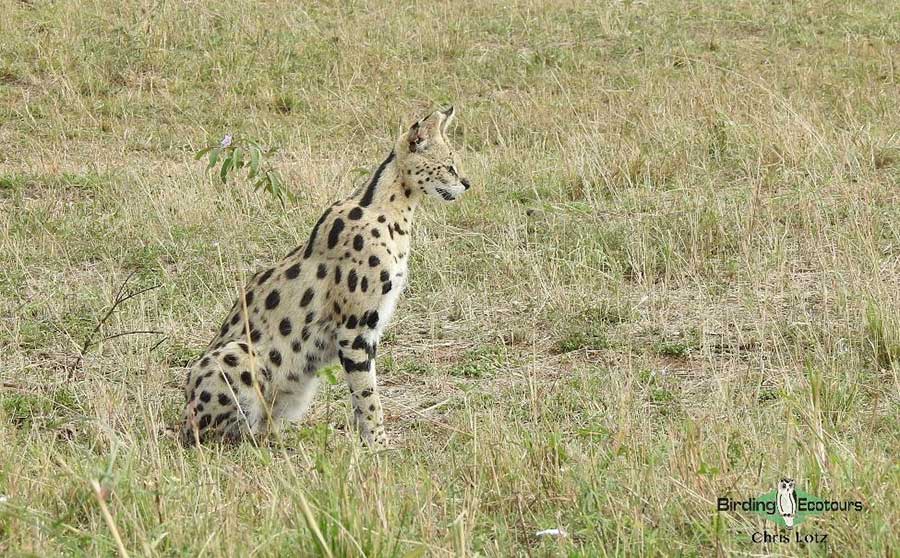
This Serval caught breakfast later – see video further down in this report.
Overview
This was another highly successful and fun Kenya birding and wildlife tour. My travel companions on this trip were an awesomely enthusiastic and fun family group who wanted to combine mammals and birds. Only one person in the group had been to sub-Saharan Africa on a quick trip once before, meaning almost all the birds and other wildlife were new to the tour participants. We did very well with our birding, accumulating a good total list, even though we spent a lot of time enjoying the big (and small) mammals. Immense luck on the animal front allowed us to see Lions successfully hunting a Plains Zebra, a Serval catching a rodent for breakfast right next to the road, Cheetahs showing really well, a Leopard nursing cubs, a mixed herd of Plains Zebras and Blue Wildebeest on migration crossing the river into Tanzania, Black and White Rhinoceros and so much more.
Bird highlights included many bustards including the world’s heaviest flying bird, Kori Bustard, both ostrich species, Secretarybird, a long list of raptors including Africa’s largest eagle, Martial Eagle, Africa’s heaviest eagle, Crowned Eagle, many accipiters and a number of excellent owls, like Northern White-faced Owl.
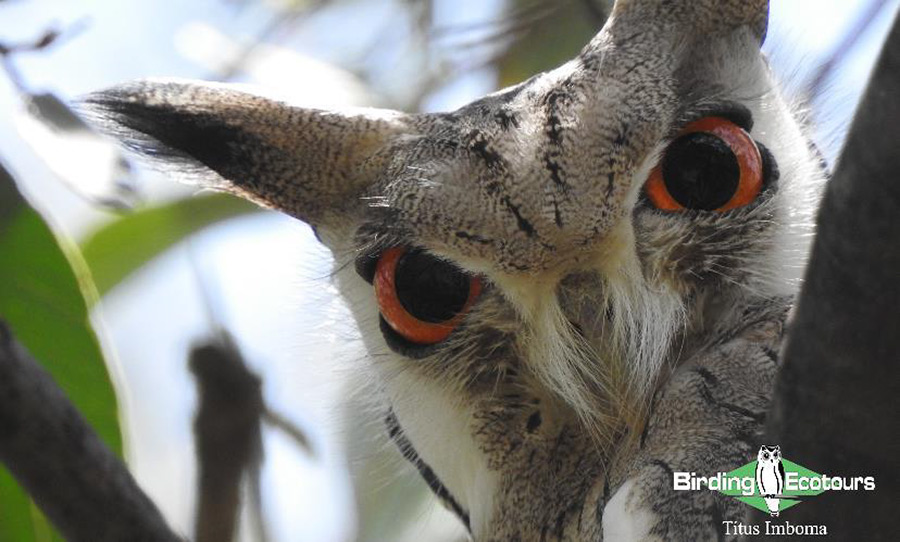
Northern White-faced Owl was one of several nocturnal birds we found at daytime roosts.
Everyone arrived in Nairobi the evening before the tour officially started, and after some sleep and then breakfast we excitedly headed off into the heart of the Great Rift Valley. After a night at a comfortable lodge on the edge of Lake Naivasha, where we picked up lots of good birds and our first mammals, we headed to the Masai Mara. Here, we spent four days enjoying the absolutely vast, unending grasslands teaming with mega-herds of game (attended by predators in the form of big cats) and a great many birds. This is truly one of the greatest national park systems on earth, contiguous with Tanzania’s Serengeti just across the border.
We then headed back to the Rift Valley Lakes for the next few days, seeing stacks of new birds in this diverse and scenic part of the world. Some of these lakes are pink with flamingos.
Kakamega Rainforest was next on our agenda, just so different from the arid areas we’d been in until now. This is arguably Africa’s best birding forest (!) and contains a lot of bird species typical of central and western Africa that reach the eastern limits of their ranges here, in additional to some far more localized species such as Turner’s Eremomela and Grey-chested Babbler. We saw so many great and beautiful birds here at Kakamega, e.g. some delightful, diminutive wattle-eyes with Yellow-bellied Wattle-eye being the most dazzling of all; a brightly-colored, tiny and cute bird. Another of the many highlights here was Great Blue Turaco, one of several spectacular turaco species we enjoyed on the tour as a whole. During our three-night stay at Kakamega, we also did a day trip to Africa’s biggest lake, Lake Victoria, where we saw the localized and beautiful Papyrus Gonolek and many other birds.
We then headed to Mount Kenya, Africa’s second highest mountain at 17,057 feet (5,199 meters). We enjoyed the cool, crisp mountain air here, along with a bunch of new trip birds, including some very localized species, as we ascended through the forests and eventually into the moorland above the tree line (the haunt of Kenya’s endemic Jackson’s Spurfowl, two species of long-tailed, beautiful malachite sunbirds and other target birds).
The trip came to a grand finale at Samburu National Park, where we added a great many new species of birds and some new mammals, such as Grevy’s Zebra and Reticulated Giraffe. Some of the many bird highlights here were the most spectacular of all the starlings, Golden-breasted Starling, Kori Bustard, and plenty more.
Sadly the tour had to eventually come to an end in Nairobi, but we had a great session at Nairobi National Park before heading to the airport. All in all, this was a spectacular tour, as any birding/wildlife tour of East Africa always is.
Detailed Report
Day 1, 1st September 2024. Nairobi to Lake Naivasha via Gatamaiyu Forest
Everyone arrived late the previous night, then we set off after breakfast, excited about our first day of Kenyan birding! It was difficult to leave our Nairobi hotel’s parking lot, as numerous birds were flitting around. None of these were rare, but virtually all of them were new for our group of six American birders, only one of whom had briefly been to sub-Saharan Africa before. Birds we saw here included Baglafecht Weaver, African Pied Wagtail and some sunbird species.
We then headed out of Nairobi and our first stop was at Manguo Swamp. Here we found the strange-looking White-backed Duck and some other duck species, such as a lot of White-faced Whistling Ducks and a handful of Fulvous Whistling Ducks. We also saw a Glossy Ibis among many Hadada Ibises and a few Sacred Ibises, a Yellow-billed Stork, a few Great Egrets, a couple of Black-headed Herons, a Grey Heron, African Swamphens, an African Jacana with a chick, and various others.
We continued our journey further to an amazing viewpoint over the Great Rift Valley. Here, we enjoyed good views of a Rufous-breasted Sparrowhawk, our first White-eyed Slaty Flycatchers and at least five stunning Golden-winged Sunbirds. We also enjoyed superb views across the rift valley, including of the volcano, Mount Longonot.
We then reached Gatamaiyu Forest where we spent a couple of amazing hours birding. Species here included the stunningly beautiful Hartlaub’s Turaco with its crimson wings in flight, a well-patterned Mountain Buzzard, a Grey Cuckooshrike that showed well, Mountain Oriole, Black-throated Wattle-eye, Black-backed Puffback, a close-up White-browed Crombec, good numbers of highly vocal Chestnut-throated Apalises and a Grey Apalis, Black Saw-wing, many Abyssinian Thrushes and Kikuyu White-eyes, three Kenrick’s Starlings and dazzling Northern Double-collared Sunbirds. Weavers were great, with Spectacled and Brown-capped Weavers both showing a couple of times. We also saw all three of the greenbuls we were hoping for at this site, Yellow-whiskered, Olive-breasted and Slender-billed Greenbuls.
We continued our journey, making several stops en route to Lake Naivasha, where we would be overnighting. These stops were productive for adding new species to our list includingCape Crow, Nyanza Swift, White-rumped Swift, Hamerkop, Augur Buzzard, Pied Kingfisher, Northern Fiscal, Brown-throated Martin, Stout Cisticola, Long-tailed Widowbird and Blacksmith Lapwing.
Day 2, 2nd September 2024. Lake Naivasha to the Masai Mara
A pre-breakfast walk around our lodge and on the lakeside generated 46 bird species, many of them new for the trip and life-birds for the group. These included many Pied Kingfishers, some Malachite Kingfishers and a pair of impressive Giant Kingfishers, a stunningly beautiful Lilac-breasted Roller and a couple of White-fronted Bee-eaters.Also present were Black Crakes, less skulking than most rallids and really attractive birds, with their bright red legs and luminous yellow bills, Long-toed Lapwing, Common Sandpiper, Green Sandpiper, Wood Sandpiper, Gull-billed Tern, various herons and egrets including Squacco Heron, African Fish Eagles with their beautiful calls (one of the most characteristic sounds of Africa) and various other waterbirds.
The trees in the lodge grounds were highly productive, with great birds like African Hoopoe, Green Wood Hoopoe, African Grey Woodpecker, Nubian Woodpecker, Black-headed Oriole, Fork-tailed Drongo, Grey-backed Fiscal, Rattling Cisticola, Wattled Starling, Ruppell’s Starling, Superb Starling, Greater Blue-eared Starling and others.
After breakfast, we packed the vehicles, seeing some star birds in the parking lot. These included two Black Sparrowhawks that flew over us a couple of times, a Red-chested Cuckoo, a pair of Ruppell’s Robin-Chats and an African Dusky Flycatcher.
We then embarked on our long drive to the vast plains of the Masai Mara, one of the planet’s greatest wildlife havens. At a restroom stop we saw a huge flock of Red-billed Queleas.At our lunch stop en route, we saw our first Hildebrandt’s Starlings, some beautiful Purple Grenadiers, a Red-fronted Barbet and a Cardinal Woodpecker.
At the entrance to the Masai Mara National Reserve, while entrance paperwork was being done, we found yet more trip birds. These came in the form of African Grey Flycatcher, Northern White-crowned Shrike, our first of many Crowned Lapwings and White-browed Sparrow-Weavers with their messy nests.
We were filled with excitement as we entered the reserve proper, one of Africa’s greatest game parks and contiguous with the Serengeti in adjacent Tanzania. We did a game drive for the rest of the afternoon, during which we saw Black Rhino, Cheetah, Warthog, Masai Giraffe, Burchell’s Zebra, Cape Buffalo, etc. A mixed herd of zebra and buffalo allowed us to get good views of Red-billed Oxpecker, Yellow-billed Oxpecker and Wattled Starlings sitting on the backs of the animals and following them around to eat insects disturbed by the beasts as they walked through the grass.Other birds also abounded (as they always do in Kenya) and we enjoyed sightings of Common Ostrich, Senegal Lapwing, African Wattled Lapwing, Saddle-billed Stork, White-backed Vulture, Martial Eagle (Africa’s largest eagle), colorful Little Bee-eaters, long-tailed Magpie Shrikes, Sooty Chats, Anteater Chats, large Red-breasted Swallows and Wire-tailed Swallow.
Day 3, 3rd September 2024. Our first of three full days in the Mara
What an incredible day!
Birds were, as usual, prolific today. On a pre-breakfast walk around the camp, we got acquainted with a Grey-headed Kingfisher,an African Paradise Flycatcher,an African Goshawk doing it’s typical early morning display, our first Emerald-spotted Wood Doves with their shining wing spots, many Speckled Mousebirds, a group of White-browed Robin-chats singing beautifully, two Brown-throated Wattle-eyes (one of them an immature), Grey-backed Camaroptera, Collared Sunbird, Marico Sunbird, Spectacled Weaver and more. A massive Nile Crocodile was right in front of the restaurant.
After breakfast, we spent the whole day doing an extended game/birding drive. Some of the most spectacular highlights were seeing a Leopard with her two cubs, a pride of Lions getting ready to hunt, and a migrating herd of Blue Wildebeest and Burchell’s Zebras crossing the river on their incredible migration journey from Kenya into Tanzania.
Bird-wise during this magnificent game drive around the park, we saw over 70 species. Highlights were White-bellied Bustard, Hartlaub’s Bustard, Common Ostrich, Secretarybird strutting confidently over the vast plains, Yellow-throated Sandgrouse, Coqui Francolin, Red-necked Spurfowl, White-browed Coucal, Grey Kestrel, Bateleur and several other eagle species, White-headed Vulture, Lappet-faced Vulture, Hooded Vulture and White-backed Vulture, Usambiro Barbet (a localized East African endemic), Rufous-tailed Weaver (almost endemic to Tanzania but marginally occurring here in Kenya as well, right along the border where we were), Speckle-fronted Weaver, Grey-capped Social Weaver, Black-crowned Tchagra, Brown-crowned Tchagra, Fischer’s Sparrow-Lark, Rufous-naped Lark, Silverbird, Golden-breasted Bunting and many others.
What a day for mammals and birds!
Day 4, 4th September 2024. Our second of three full days in the Mara
Like yesterday, we started today with a pre-breakfast walk around our lodgings. A couple of folks saw a cute Northern Lesser Galago (bushbaby) between their luxury en suite safari tents and the meeting place for our morning walk. We added a few new birds to our growing list. These were African Woolly-necked Stork, Spot-flanked Barbet, Tawny-flanked Prinia, Yellow-breasted Apalis and Tropical Boubou. A large troop of extremely cute, and personality-filled Banded Mongooses distracted us while we were eating breakfast.
We spent most of our day driving through the endless rolling grasslands of the Mara. This was another incredible day in paradise! Being surrounded by endless herds of zebras, wildebeest and gazelles, with elephants, giraffes, warthogs and predators all over the place as well, was like being in the midst of a wonderful dream. The real highlight of the day, however, was seeing a Serval hunting right next to the road and eventually catching a rodent right in front of us.
Other great sightings of our morning session included more close-up Lions, Southern Ground Hornbills, White-bellied Bustard, Black-bellied Bustard, characterful Bare-faced Go-away-bird, Goliath Heron, much closer vultures than on previous days, including the new trip bird Rüppell’s Vulture, a pair of Chinspot Batises, Banded Martins, Bronze Mannikin, Red-cheeked Cordon-bleu, Northern Grey-headed Sparrow and various others.
The afternoon was equally productive. We spent quite a bit of time driving along the Tanzania border, with the Serengeti on our left and the Masai Mara in Kenya to the right. We observed many good birds (as well as the usual herds of game as far as the eye could see) in this area. The birds included, among others, Red-winged Francolin, Quailfinch, Temminck’s Courser, Red-capped Lark, Rufous-naped Lark, White-headed Buffalo Weaver, White-browed Coucal, Rufous-tailed Weaver, Black-chested Snake Eagle and Dark Chanting Goshawk.
As we approached our lodge, we got entertained by a close-up Black-backed Jackal.
Day 5, 5th September 2024. Our third of three full days in the Mara
This was another magnificent day (like all days in the Masai Mara). After breakfast, we spent some time birding in the parking area. There was a mixed flock of four swift species, one of them new for the trip, Horus Swift. There were also several sunbirds around, and one of these was also a new trip bird, Scarlet-chested Sunbird. We also laid eyes on our first Red-fronted Tinkerbird; until now this had been a heard only bird.
We then embarked on relaxed birding and game drives before lunch and in the late afternoon (with a delicious lunch back at the lodge). The pressure was off, as we had already seen most of our main targets a little quicker than expected, thanks to great luck and the skill of our ground team. At one of the many stops we made, while enjoying watching a herd of Elephants, a Wahlberg’s Eagle swooped down in an attempt to catch something. This turned out to be a Harlequin Quail,which escaped and flew off, giving some of us a view. Unfortunately, an African Crake that was initially on the side of the road and which then walked into the long grass, was also only seen by a couple of us.
Later in the day, we found two more Grey Kestrels and a Gabar Goshawk. We also added a few other bird species to our growing bird list, e.g. Croaking Cisticola, Village Weaver, Common Waxbill, etc.
As always, mammals were good. We found yet another Lion, this one busy eating.

Elephants with youngsters on the Tanzania border, where the Masai Mara meets the Serengeti.
Day 6, 6th September 2024. The Mara back to Lake Naivasha
This was not a bad day for a travel day! It started with our last drive through the park, and we enjoyed seeing all the usual mammals and birds, as well as quite a number of Spotted Hyenas, and five Cheetahs! We also got a flat tire, but it turned out to be a blessing in disguise as we saw (and heard the nice liquid calls of) a small flock of European Bee-eaters migrating south just as we stepped out of the vehicle!
Once we left the park, we stopped for a break and what a lucky stop that also turned out to be! We saw a few new trip species, namely Red-billed Buffalo Weaver, many Speke’s Weavers, Chestnut Sparrow and White-bellied Canary, among some other good birds we’d seen before, like Usambiro Barbet and Speckle-fronted Weaver.
Another brief stop further along generated a number of Great White Pelicans, Yellow-billed Duck and a couple of other birds we’d already seen earlier in the trip.
We arrived at Lake Naivasha in time for afternoon tea at the idyllic Elsamere Lodge, where we would spend the next two nights. A relaxed walk in the late afternoon for a couple of hours allowed us to record 57 bird species, a great total for a short session virtually within the lodge grounds. Highlight species included a beautiful Spotted Eagle-Owl at its day-time roost, many low-flying Mottled Swifts and a few Nyanza Swifts, noisy Green Wood Hoopoes, a Lesser Honeyguide, male (black) and female (very different, largely a grey bird with yellow barring) Black Cuckooshrikes, very colorful Grey-headed Bushshrike, a couple of White-bellied Tits, Grey-capped Warbler, Variable Sunbird and some other sunbird species, Red-headed Weaver and more. We also saw small flocks of lovebirds, originally from Tanzania, that have now become feral in Kenya, hybrids of Fischer’s and Yellow-collared Lovebirds.
Day 7, 7th September 2024. A full day around Lake Naivasha
We started the day with a pre-breakfast walk around the lodge, averaging a bird species every minute, with 35 bird species in about 35 minutes. The only new trip bird was Hildebrandt’s Spurfowl, though.
After breakfast, we went to Sanctuary Farm about a half hour drive from the lodge, and took a boat trip to Crescent Island. One of the top birds was a nicely perched African Hobby,which we got decent scope views of. There’s a spectacularly high density of African Fish Eagles here and they were simply all over the place. African Spoonbill, ibises in the form of Glossy, Hadada and African Sacred, Yellow-billed Storks, all the Kenyan egret species, Great White Pelican, Little Grebe and many other waterbirds, were much in evidence. We found our first Buff-bellied Warblers, Red-faced Crombec, Cape Robin-Chat, Klaas’s Cuckoos (a bright iridescent green adult, and a duller immature) and Brown-backed Honeybird for the trip, all really solid, high quality birds to add to our list. There were plenty of Pied Kingfishers, three or four Giant Kingfishers, and good numbers of Nubian and African Grey Woodpeckers as well. We also saw a great many other birds we were already well familiar with from previous days of the trip. All in all, this session between breakfast and lunch generated 65 bird species and also a good number of mammals.
During our tasty lunch back at the lodge, we enjoyed seeing beautiful Guereza (Black-and-white Colobus Monkeys). We then enjoyed a two hour break in the heat of the day before visiting a site for Grey-crested Helmetshrike, a very localized bird only found in small parts of Kenya and Tanzania. Unfortunately, we didn’t see this species on this occasion but did add Bearded Woodpecker to our growing bird list.
Day 8, 8th September 2024. Lake Naivasha to Lake Bogoria
Although this was partly a travel day, it was also very exciting, as a lot of new bird species awaited us around Lake Bogoria after we crossed the Equator (stopping to take photos of the sign as we did so). The first new species right at the Equator stop, was the personality-filled White-bellied Go-away-bird. As we moved further northwards, we saw our first Blue-naped Mousebirds, a stunningly beautiful Northern Red Bishop, Beautiful Sunbird and lovely Spotted Palm Thrush.
We eventually reached Lake Bogoria, where we saw thousands of Lesser Flamingos and a handful of Greater Flamingos. Here, we also added numerous other species to our growing bird list, like Black-winged Stilt, Mourning Collared Dove, Namaqua Dove, Eastern Violet-backed Sunbird, Eastern Chanting Goshawk, Jackson’s Hornbill, Slate-colored Boubou, Lesser Masked Weaver, Vitelline Masked Weaver, Northern Masked Weaver and Chestnut Weaver. In Kenya, one doesn’t have to travel far to get into areas full of new birds; habitats and birdlife changes quickly here.
Between Lake Bogoria and our hotel, we saw some additional good birds, as well as a Leopard Tortoise that Alexa spotted along the side of the road. New birds were Northern Red-billed Hornbill, Red-and-yellow Barbet and Pygmy Falcon, all star species for sure.
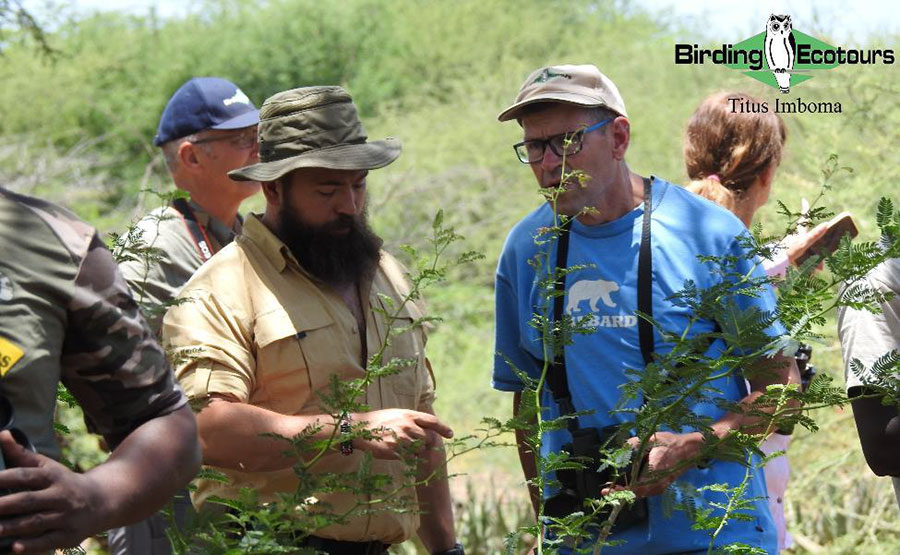
Sometimes we looked at other things apart from birds.
Day 9, 9th September 2024. A full day around Lake Baringo
This was another super-amazing day with many new trip birds. We started with a pre-breakfast boat trip on Lake Baringo. The bird count for this two-hour boat trip was 59 species. Some of the many highlights were Woodland Kingfisher, a close-up Giant Kingfisher, a great many Olive Bee-eaters, a few Gull-billed Terns, good numbers of African Darters, several White-faced Whistling Ducks, quite a lot of Purple Herons and various other heron species, brightly-colored Golden-backed Weavers and quite a number of other weavers we’d already previously seen.
When we arrived back at the lodge after the boat trip, a Northern Brownbul (another new bird for the trip), greeted us. Stunning Spotted Palm Thrushes were also much in evidence around the lodge; this lovely bird is often tame around accommodations in East Africa.
After an awesome breakfast, we left the lodge for some terrestrial birding, seeing a Pin-tailed Whydah on the way out. We had an expert local birding guide with an incredibly sharp eye along and he knew the daytime roosting sites for a number of nocturnal species. Three-banded Courser was the first one on the birding menu, followed shortly by Spotted Thick-knee. The thick-knee roost site also generated some other new trip birds like Blue-naped Mousebird, Hemprich’s Hornbill (one of our main targets for today and found a bit earlier than expected), Pygmy Batis, tiny Mouse-colored Penduline Tits, a Yellow-bellied Eremomela and vocal Grey Wren-Warblers.
We then went to another site where there was a roosting Slender-tailed Nightjar. This time, the supporting cast of new trip birds came in the form of the tiny, metallic green Diederik Cuckoo, Brubru with its phone-like “song”, Little Weaver and a superbly colorful Green-winged Pytilia.
A cute pair of orange-eyed Northern White-faced Owls were next on the agenda. As usual, other new trip birds made appearances as well. These were Northern Red-billed Hornbill, Northern Crombec and Rufous Chatterer.
Our final stop before lunch was to admire a gorgeous pair of Greyish Eagle-Owls, accompanied by Purple Roller and Magpie Starling.
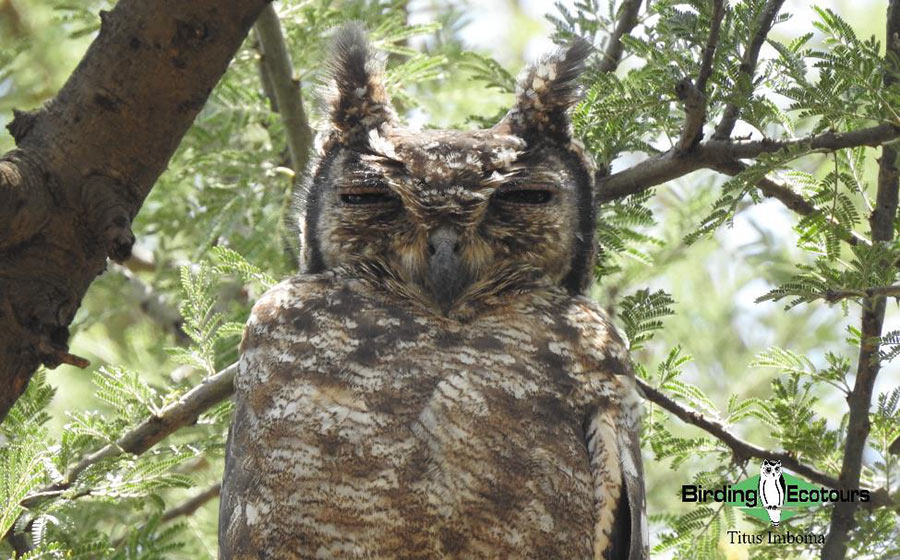
One of the pair of Greyish Eagle-Owls.
After lunch, we spent a couple of hours resting and regrouping during the heat of the day. We ended the day with a late afternoon session at the base of an impressive cliff face. This session turned into a grand finale (for Baringo), boasting many new and spectacular birds. The new birds were Crested Francolin, Village Indigobird, African Green Pigeon, Great Spotted Cuckoo, (and heard only Jacobin Cuckoo), Pearl-spotted Owlet, African Grey Hornbill, Acacia Tit, Red-fronted Prinia, Bristle-crowned Starling, Red-winged Starling, Mocking Cliff Chat, the localized Brown-tailed Rock Chat (one of our main targets, albeit a very dull bird) and last but not least, Shining Sunbird.
Day 10, 10th September 2024. Lake Baringo to Kakamega
Although this was a travel day, it was superbly exciting, with absolutely new habitats and therefore birds.
Our first stop was at Chebloch Gorge/Kerio Valley, which was spectacular! The star of the show here was a beautiful White-crested Turaco showing off its crimson wings in flight. Meyer’s Parrots showed closely, although briefly. Crowned Hornbill and a couple of other hornbill species we’d already seen, put in appearances. Displaying pairs of Red-and-yellow Barbets and new for the trip D’Arnaud’s Barbets were, as always, very showy. A vocal Black-headed Gonolek showed briefly. White-headed Saw-wings flitted their way around us. Amethyst Sunbirds and a number of other species we’d seen before, were also around.
We stopped for cooldrinks and a leg stretch around mid-morning and enjoyed seeing Fan-tailed Ravens interacting with more common Pied Crows. A couple of Reichenow’s Seedeaters were also around. After lunch, we stopped briefly to look at a pair of Grey Crowned Cranes and a Crowned Eagle, both such spectacular species!
After checking into Rondo Retreat in the Kakamega Forest (an Important Bird and Biodiversity Area in Danger), we waited out a bit of rain before doing a brief but spectacular birding session. A major highlight was seeing a couple of Great Blue Turacos, Planet Earth’s largest turaco species. Other star birds were an immature Crowned Eagle showing well, huge, noisy Black-and-white-casqued Hornbills, African Blue Flycatcher, Yellow-throated Leaflove and Vieillot’s Black Weaver.
Day 11, 11th September 2024. A full day of birding around Kakamega
We started the day with an hour-long pre-breakfast walk around our lodge and marginally into the adjacent forest. A Mackinnon’s Fiscal was one of the first birds we encountered. We enjoyed great views of the immature Crowned Eagle again and heard the resounding call of Great Blue Turaco, reminding us of the views we got yesterday. Black-and-white-casqued Hornbills also gave their incredibly loud calls and showed well as they winged noisily overhead. We added two new barbets, Grey-throated and Hairy-breasted. Luhder’s Bushshrike showed quite well. Joyful Greenbuls provided a splash of yellow and cheerful singing for us. Cabanis’s Greenbul also showed. Green-headed Sunbird and Bronzy Sunbird fed at flowers in the garden.
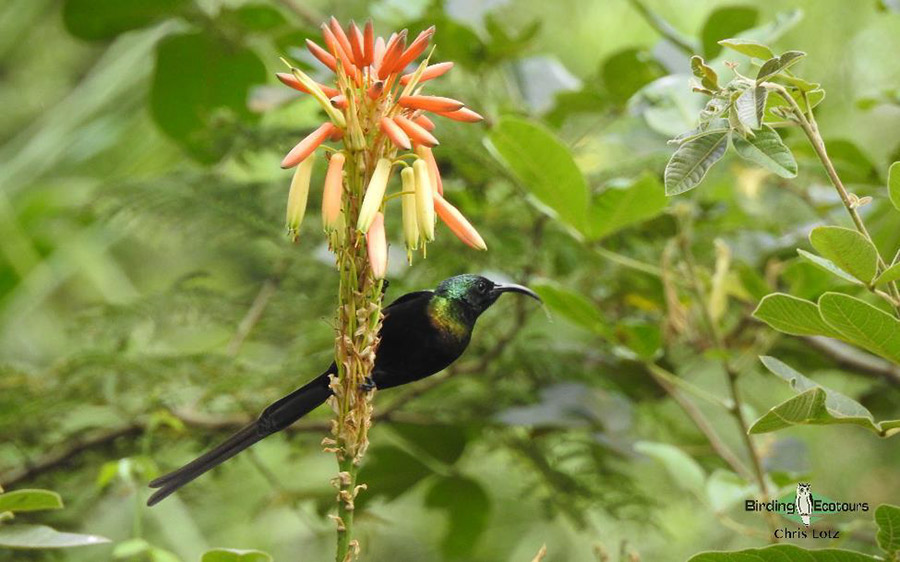
Bronzy Sunbird was one of several long-tailed sunbird species we encountered on this tour.
After breakfast, we enjoyed spectacular birding that Kakamega is famous for. Early during the session, we located some Turner’s Eremomelas and saw them well. This is a major special here as this and the nearby South and North Nandi Forests are the only realistic places for birders to see this species, although there are some isolated sites for this species in the DRC. We also saw Red-headed Bluebill and Dark-backed Weaver early in the session. We added a couple more spectacular barbetsin the form of Yellow-billed Barbet and Yellow-spotted Barbet. A Yellow-crested Woodpecker showed well, as did a pair of Purple-throated Cuckooshrikes. Chapin’s Flycatcher, Olive Sunbird, Olive-bellied Sunbird, Ashy Flycatcher, Brown-chested Alethe, Ansorge’s Greenbul and, briefly, a vocal Grey-chested Babbler (another Kakamega Forest special, with Kakamega as its genus and sometimes common name) were a few more highlights. Jameson’s Wattle-eye was awesome to see, and one amazing stop generated a few Sooty Tits, a Sharpe’s Drongo and the most popular bird of the day, Red-headed Malimbe. There were a few Southern Hyliotas around, and also White-chinned Prinias. White-breasted Nigrita was also a very popular bird as per comments from our birding group. Near the end of our session, just before lunch, we enjoyed some Chubb’s Cisticolas duetting as they love to do.
As we arrived back at our lodge, we admired some beautiful sunbirds in flowering trees. These included Grey-chinned and Green-throated Sunbirds.
After a couple of hours of resting, we went to the Kakamega park headquarters, adding two new bee-eaters to our growing list, White-throated and Blue-headed Bee-eaters, both of which we scoped high up in trees.
Our last birding stop of the day was (as usual) highly productive, with co-operative Tambourine Doves, a pair of Blue-shouldered Robin-Chats singing nicely and, unusually, actually showing a few times as they crossed the road, good views of Black-faced Rufous Warblers (which we had, however, heard a lot all day long), beautiful Black-collared Apalis, Grey-headed Nigrita, Black Cuckoo and others.
Mammal-wise we, enjoyed seeing Red-tailed Monkey, Blue Monkey and Guereza (Black-and-white Colobus Monkey).
Day 12, 12th September 2024. In search of Papyrus endemics around Africa’s largest lake, Lake Victoria
After breakfast, we headed for Yala Swamp near Lake Victoria. En route, we stopped at a site for Rock Pratincoles, also seeing a few bonus birds like African Harrier-Hawk, Long-crested Eagle, Black-lored Babbler, Broad-billed Roller and Brown-backed Scrub Robin in the vicinity. Continuing towards Yala Swamp with its extensive Papyrus beds, we stopped briefly to enjoy a close-up Lizard Buzzard.
The best bird at Yala Swamp was the stunningly beautiful Papyrus Gonolek which eventually showed very well after testing our patience for a while. We also got good views of Swamp Flycatcher. Various other new trip birds were also around, e.g. Blue-spotted Wood Dove and Blue-cheeked Bee-eater.
We then visited Port Bunyala to view Lake Victoria, the largest of Africa’s great lakes.
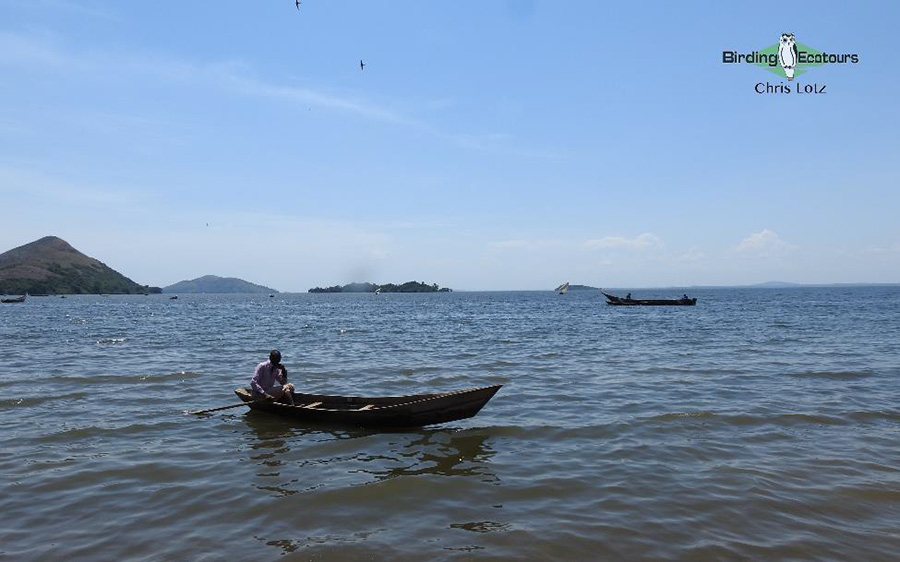
Lake Victoria is shared by Kenya, Uganda and Tanzania.
Day 13, 13th September 2024. Kakamega to Lake Nakuru
After breakfast, we did some final Kakamega Forest birding before heading for Nakuru National Park. This last session of Kakamega birding was spectacular. We managed to find a co-operative pair of beautiful, dainty Yellow-bellied Wattle-eyes within a mixed flock also including some other great new trip birds in the form of Pale-breasted Illadopsis, Red-tailed Bristlebill and Kakamega Greenbul.
A stop at the river slightly further along the road, still within Kakamega Forest, generated several Greenbuls such as Ansorge’s and Cabanis’s, a very co-operative African Pygmy Kingfisher and many other birds.
As we drove out of the forest, a very lucky stop gave us two new trip birds all in the same bush without us having to get out of the car. These were Cinnamon-chested Bee-eater and African Firefinch, both so colorful. We drove the couple of hours to our lodge inside Lake Nakuru National Park, then enjoyed wonderful views over the lake and grasslands from the outside seating area of the restaurant while we ate a scrumptious lunch.
After an hour of resting, we then enjoyed a spectacular afternoon game and birding drive in which we had an amazing surprise (see below). We saw 63 species of birds on this three-hour drive, including ten new species for the trip. We enjoyed watching flocks of Great White Pelicans fishing communally. There were also quite a number of Pink-backed Pelicans around. There were many flamingoes, primarily Lesser Flamingoes but with a couple of Greater Flamingoes as well. We were pleased to see a lot of shorebirds had already arrived from their breeding grounds (they winter in Africa), including a few species that were new for the trip, namely Ruff, Common Greenshank, Marsh Sandpiper and Common Ringed Plover. African Spoonbills foraged right next to us, providing awesome views. Several Little Grebes floated around on the water. Grey-headed Gulls and Whiskered Terns were in evidence. A couple of pairs of Grey Crowned Cranes were around, one of them providing nicely close views. Raptors were amazing, with our first Ospreys, quite a number of Augur Buzzards, a Black-chested Snake Eagle, African Harrier-Hawk and last but certainly not least, an African Cuckoo-Hawk.
The real highlights had fur, not feathers, though. We saw new mammals in the form of White Rhinos and Rothschild’s Giraffes.The most unexpected part of the day happened when we started watching a Lioness and two male Lions that at first were resting, but which started to become increasingly alert. They proceeded to climb a tree, and then they started hunting Plains Zebras. We were in disbelief as the lioness stalked carefully up to a zebra and managed to get extremely close without the zebra noticing. Next thing it ran the last few yards and brought the zebra down, soon being helped by the two males. These lions didn’t go hungry tonight!
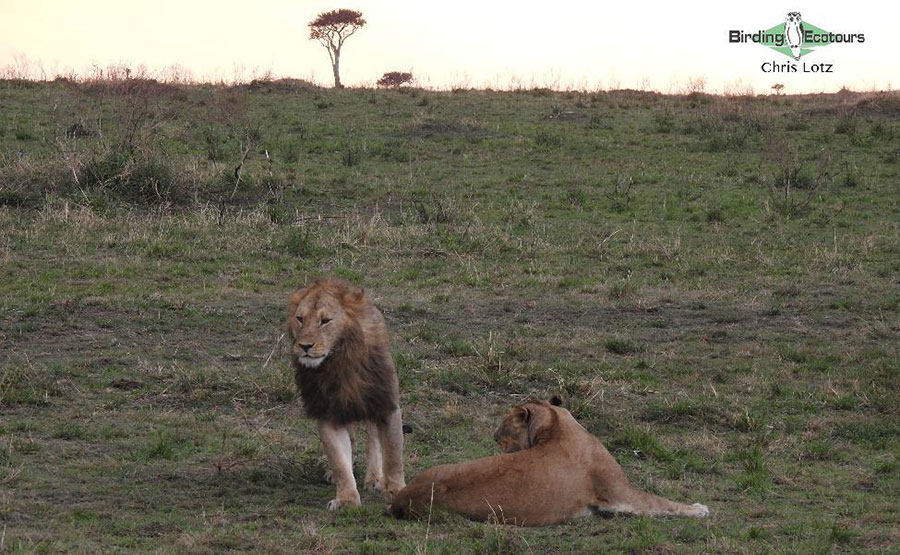
Friendly-looking Lions.
Day 14, 14th September 2024. Lake Nakuru to Mount Kenya
After breakfast, we did another spectacular game/birding drive in which we recorded 95 bird species in an hour and 25 minutes. New species we were pleased to see were Red-billed Teal, Kittlitz’s Plover, White-headed Barbet, African Thrush and Little Rock Thrush. We also enjoyed seeing some old friends really well, e.g. Golden-winged Sunbirds and close-up Grey Crowned Cranes.
Mammal-wise, we enjoyed seeing White Rhinos a bit closer up than the previous day, along with Olive Baboons with tiny babies riding on their backs or hanging onto their bellies, plus many others.
We then embarked on the couple-of-hour drive to our comfortable luxury en suite glamping accommodation with views over both Mount Kenya (an extinct volcano and Africa’s second highest peak at around 17,000 feet/5,200 meters) and the Aberdare Range. Here we had a tasty lunch before embarking on a birding/game drive around the nearby Solio Ranch, a private rhino sanctuary important in the protection and breeding of Black Rhinos and we enjoyed seeing an adult and its baby. We also got great views of White Rhinos (at times with Mount Kenya as a backdrop), and a new giraffe species, the beautifully patterned Reticulated Giraffe.
Birds we hadn’t seen before today that we enjoyed finding here were Brimstone Canary, Yellow-necked Spurfowl and hilariously noisy, personality-filled Northern Pied Babblers.
Day 15, 15th September 2024. A day around Mount Kenya
After breakfast, we headed into the spectacular Mount Kenya National Park. While paperwork was in progress, we found great birds around the main gate into the park. These included White-headed Wood Hoopoe, Sharpe’s Starling, a luminously colorful African Emerald Cuckoo and a couple of flyover species in the form of Red-fronted Parrot and African Olive Pigeon. A Mountain Buzzard showed very well as we entered the park, followed shortly by a Thick-billed Seedeater. Yellow-crowned Canaries were all over the place. As we ascended up through the park to higher altitudes, so we saw more great birds. Hartlaub’s Turacos showing their crimson wings in flight are always wonderful to see. An immature and a couple of adult Crowned Eagles were seen at close quarters. A Mountain Yellow Warbler co-operated very well and higher up a couple of Cinnamon Bracken Warblers remained more hidden. Pairs of Hunter’s Cisticolas duetted often. As we ascended through the bamboo zone and towards the end of the tree line, we saw White-starred Robin and Abyssinian Ground Thrush.
We eventually reached the moorland/heathland as we got to a high enough altitude. Here we found our targets without too much difficulty. These were Moorland Chat, Malachite Sunbird, Scarlet-tufted Sunbird and confiding Jackson’s Spurfowl (endemic to Kenya).
Moustached Tinkerbird was the highlight as we descended the mountain at the end of the afternoon.
Mammal-wise, we enjoyed seeing really confiding Defassa Waterbuck and Sykes’s Monkeys today during our exciting mountain trip.
Day 16, 16th September 2024. Mount Kenya to amazing Samburu
After breakfast, we embarked on the scenic drive (getting awesome views of Mount Kenya on the way) to Samburu National Reserve and the adjacent Buffalo Springs National Reserve. Being in a completely new habitat and region of Kenya, many new birds were added very quickly to our burgeoning list. At the entrance gate to the park, a feeding frenzy of species included several birds we hadn’t yet seen. These were the absolutely spectacular Golden-breasted Starling (African starlings can be gorgeous, and this must be the most spectacular of all of them with its unbelievable colors and long tail), Fischer’s Starling, many Donaldson-Smith’s Sparrow-Weavers and a couple of Parrot-billed Sparrows. As we drove through the park on our way to the comfortable lodge where we would stay the next two nights (and have lunch today), we added Pink-breasted Lark and Taita Fiscal to our list.
After checking in, we sat outside at the restaurant and added new birds to our list as we enjoyed our lunch buffet. These were Tsavo Sunbird and Dodson’s Bulbul.
An afternoon game/birding drive was good for mammals, including Beisa Oryx, Gerenuk with its long neck and Grevy’s Zebras with its beautiful patterns. We also continued to add new birds to our growing trip list, in the form of White-headed Mousebird, many Chestnut-bellied Sandgrouse (a lot of them flying around but a small flock also ridiculously close-up on the roadside), six Somali Ostriches, Abyssinian Scimitarbill, Lanner Falcon, stunning Rosy-patched Bushshrikes, Red-winged Lark and Pale Prinia.
Day 17, 17th September 2024. A full day in Samburu National Reserve
A couple of hours before breakfast allowed us to record 64 bird species. The highlight was a Kori Bustard showing really well. But we also thoroughly enjoyed seeing three sandgrouse species, Chestnut-bellied, Lichtenstein’s and Black-faced. A couple of Foxy Larks were also new for the trip, as was Northern Wheatear.
After breakfast, we went on another game drive and recorded 81 bird species in three hours. We also added a new mammal, Common Waterbuck, to our trip list. New bird species that we added to our list were dazzlingly bright Golden Pipits that become even more spectacular in flight with their blinding yellow wings, gorgeous Golden Palm Weavers, Greater Honeyguide, Red-bellied Parrot, Buff-crested Bustard, Von der Decken’s Hornbill, Isabelline Wheatear and Banded Parisoma.
We returned for another excellent lunch and then had a break during the heat of the day before embarking on a late afternoon birding/game drive. As always, this proved great. We found two more Kori Bustards which hunkered down when we approached and we saw only their heads and upper necks peering at us from the long grass. We found a staggering 15 White-bellied Bustards, some of them with very cute youngers, and we also found another Buff-crested Bustard for Lynn (as she had missed the later morning drive). We were amazed when a Common Buttonquail flushed off the road and gave us brief views where it landed in an opening in the grass. We briefly saw a couple of Red-bellied Parrots. One of the best bird species of the afternoon was Cut-throat Finch, several of which showed well on the road in front of us. The bird of the afternoon, a species we thought we’d miss, after looking for it all day and the previous afternoon, was the elegantly plumaged but vulture-headed Vulturine Guineafowl – what a bird to end the day with!
Day 18, 18th September 2024. Samburu to Nairobi, afternoon visit to Nairobi National Park
As we checked out of the hotel, some of the group saw a new trip bird, Black-bellied Sunbird. We then embarked on the drive back to Nairobi, arriving in time for an awesome birding drive in Nairobi National Park. Here we enjoyed seeing White Rhinos and several other good mammal species, as well as 74 bird species in three hours. These included some new trip birds: Hartlaub’s Bustard, Black-cheeked Waxbill, Cinnamon-breasted Bunting and Long-tailed Fiscal. We also thoroughly enjoyed seeing species we’d already encountered, such as a really close-up Secretarybird and a noisy flock of Northern Pied Babblers, among many others. Nairobi National Park is an amazing place, covering a huge area and allowing one to forget one is near a city. All in all, a great ending to a superb trip with fun people, who we dropped at the airport this evening for their flights home.
Bird List – Following IOC (December 2023 version)
Birds ‘heard only’ are marked with (H) after the common name, all other species were seen. The following notation after species names is used to show conservation status following BirdLife International: CR = Critically Endangered, EN = Endangered, VU = Vulnerable, DD = Data Deficient.
| Common name | Scientific name |
| Ostriches (Struthionidae) | |
| Common Ostrich | Struthio camelus |
| Somali Ostrich – VU | Struthio molybdophanes |
| Ducks, Geese, Swans (Anatidae) | |
| White-faced Whistling Duck | Dendrocygna viduata |
| Fulvous Whistling Duck | Dendrocygna bicolor |
| Egyptian Goose | Alopochen aegyptiaca |
| Yellow-billed Duck | Anas undulata |
| Red-billed Teal | Anas erythrorhyncha |
| Guineafowl (Numididae) | |
| Helmeted Guineafowl | Numida meleagris |
| Vulturine Guineafowl | Acryllium vulturinum |
| Pheasants & Allies (Phasianidae) | |
| Crested Francolin | Ortygornis sephaena |
| Coqui Francolin | Campocolinus coqui |
| Red-winged Francolin | Scleroptila levaillantii |
| Harlequin Quail | Coturnix delegorguei |
| Jackson’s Spurfowl | Pternistis jacksoni |
| Hildebrandt’s Spurfowl | Pternistis hildebrandti |
| Yellow-necked Spurfowl | Pternistis leucoscepus |
| Red-necked Spurfowl | Pternistis afer |
| Nightjars (Caprimulgidae) | |
| Slender-tailed Nightjar | Caprimulgus clarus |
| Swifts (Apodidae) | |
| African Palm Swift | Cypsiurus parvus |
| Mottled Swift | Tachymarptis aequatorialis |
| Common Swift | Apus apus |
| Nyanza Swift | Apus niansae |
| Little Swift | Apus affinis |
| Horus Swift | Apus horus |
| White-rumped Swift | Apus caffer |
| Turacos (Musophagidae) | |
| Great Blue Turaco | Corythaeola cristata |
| Bare-faced Go-away-bird | Crinifer personatus |
| White-bellied Go-away-bird | Crinifer leucogaster |
| Purple-crested Turaco | Gallirex porphyreolophus |
| White-crested Turaco | Tauraco leucolophus |
| Hartlaub’s Turaco | Tauraco hartlaubi |
| Bustards (Otididae) | |
| Kori Bustard | Ardeotis kori |
| White-bellied Bustard | Eupodotis senegalensis |
| Buff-crested Bustard | Lophotis gindiana |
| Black-bellied Bustard | Lissotis melanogaster |
| Hartlaub’s Bustard | Lissotis hartlaubii |
| Cuckoos (Cuculidae) | |
| Blue-headed Coucal | Centropus monachus |
| White-browed Coucal | Centropus superciliosus |
| Great Spotted Cuckoo | Clamator glandarius |
| Jacobin Cuckoo | Clamator jacobinus |
| Diederik Cuckoo | Chrysococcyx caprius |
| Klaas’s Cuckoo | Chrysococcyx klaas |
| African Emerald Cuckoo | Chrysococcyx cupreus |
| Black Cuckoo | Cuculus clamosus |
| Red-chested Cuckoo | Cuculus solitarius |
| Sandgrouse (Pteroclidae) | |
| Chestnut-bellied Sandgrouse | Pterocles exustus |
| Yellow-throated Sandgrouse | Pterocles gutturalis |
| Black-faced Sandgrouse | Pterocles decoratus |
| Lichtenstein’s Sandgrouse | Pterocles lichtensteinii |
| Pigeons, Doves (Columbidae) | |
| Rock Dove | Columba livia |
| Speckled Pigeon | Columba guinea |
| African Olive Pigeon | Columba arquatrix |
| Mourning Collared Dove | Streptopelia decipiens |
| Red-eyed Dove | Streptopelia semitorquata |
| Ring-necked Dove | Streptopelia capicola |
| Laughing Dove | Spilopelia senegalensis |
| Emerald-spotted Wood Dove | Turtur chalcospilos |
| Blue-spotted Wood Dove | Turtur afer |
| Tambourine Dove | Turtur tympanistria |
| Namaqua Dove | Oena capensis |
| African Green Pigeon | Treron calvus |
| Rails, Crakes & Coots (Rallidae) | |
| African Crake | Crecopsis egregia |
| Common Moorhen | Gallinula chloropus |
| Red-knobbed Coot | Fulica cristata |
| African Swamphen | Porphyrio madagascariensis |
| Black Crake | Zapornia flavirostra |
| Cranes (Gruidae) | |
| Grey Crowned Crane – EN | Balearica regulorum |
| Grebes (Podicipedidae) | |
| Little Grebe | Tachybaptus ruficollis |
| Flamingos (Phoenicopteridae) | |
| Greater Flamingo | Phoenicopterus roseus |
| Lesser Flamingo | Phoeniconaias minor |
| Buttonquail (Turnicidae) | |
| Common Buttonquail | Turnix sylvaticus |
| Stone-curlews, Thick-knees (Burhinidae) | |
| Spotted Thick-knee | Burhinus capensis |
| Water Thick-knee (H) | Burhinus vermiculatus |
| Stilts, Avocets (Recurvirostridae) | |
| Black-winged Stilt | Himantopus himantopus |
| Pied Avocet | Recurvirostra avosetta |
| Plovers (Charadriidae) | |
| Common Ringed Plover | Charadrius hiaticula |
| Three-banded Plover | Charadrius tricollaris |
| Long-toed Lapwing | Vanellus crassirostris |
| Blacksmith Lapwing | Vanellus armatus |
| Spur-winged Lapwing | Vanellus spinosus |
| Senegal Lapwing | Vanellus lugubris |
| Crowned Lapwing | Vanellus coronatus |
| African Wattled Lapwing | Vanellus senegallus |
| Kittlitz’s Plover | Anarhynchus pecuarius |
| Jacanas (Jacanidae) | |
| African Jacana | Actophilornis africanus |
| Sandpipers, Snipes (Scolopacidae) | |
| Common Sandpiper | Actitis hypoleucos |
| Green Sandpiper | Tringa ochropus |
| Marsh Sandpiper | Tringa stagnatilis |
| Wood Sandpiper | Tringa glareola |
| Common Greenshank | Tringa nebularia |
| Ruff | Calidris pugnax |
| Little Stint | Calidris minuta |
| Coursers, Pratincoles (Glareolidae) | |
| Three-banded Courser | Rhinoptilus cinctus |
| Temminck’s Courser | Cursorius temminckii |
| Rock Pratincole | Glareola nuchalis |
| Gulls, Terns, Skimmers (Laridae) | |
| Gull-billed Tern | Gelochelidon nilotica |
| Whiskered Tern | Chlidonias hybrida |
| Grey-headed Gull | Chroicocephalus cirrocephalus |
| Lesser Black-backed Gull | Larus fuscus |
| Storks (Ciconiidae) | |
| African Openbill | Anastomus lamelligerus |
| Marabou Stork | Leptoptilos crumenifer |
| Yellow-billed Stork | Mycteria ibis |
| Saddle-billed Stork | Ephippiorhynchus senegalensis |
| African Woolly-necked Stork | Ciconia microscelis |
| Anhingas, Darters (Anhingidae) | |
| African Darter | Anhinga rufa |
| Cormorants, Shags (Phalacrocoracidae) | |
| Reed Cormorant | Microcarbo africanus |
| White-breasted Cormorant | Phalacrocorax lucidus |
| Ibises, Spoonbills (Threskiornithidae) | |
| African Sacred Ibis | Threskiornis aethiopicus |
| Hadada Ibis | Bostrychia hagedash |
| Glossy Ibis | Plegadis falcinellus |
| African Spoonbill | Platalea alba |
| Herons, Bitterns (Ardeidae) | |
| Black-crowned Night Heron | Nycticorax nycticorax |
| Black Heron | Egretta ardesiaca |
| Little Egret | Egretta garzetta |
| Striated Heron | Butorides striata |
| Squacco Heron | Ardeola ralloides |
| Western Cattle Egret | Bubulcus ibis |
| Great Egret | Ardea alba |
| Yellow-billed Egret | Ardea brachyrhyncha |
| Grey Heron | Ardea cinerea |
| Purple Heron | Ardea purpurea |
| Black-headed Heron | Ardea melanocephala |
| Goliath Heron | Ardea goliath |
| Hamerkop (Scopidae) | |
| Hamerkop | Scopus umbretta |
| Pelicans (Pelecanidae) | |
| Great White Pelican | Pelecanus onocrotalus |
| Pink-backed Pelican | Pelecanus rufescens |
| Secretarybird (Sagittariidae) | |
| Secretarybird – EN | Sagittarius serpentarius |
| Ospreys (Pandionidae) | |
| Osprey | Pandion haliaetus |
| Kites, Hawks, Eagles (Accipitridae) | |
| Black-winged Kite | Elanus caeruleus |
| African Harrier-Hawk | Polyboroides typus |
| African Cuckoo-Hawk | Aviceda cuculoides |
| Hooded Vulture – CR | Necrosyrtes monachus |
| White-backed Vulture – CR | Gyps africanus |
| Rüppell’s Vulture – CR | Gyps rueppelli |
| White-headed Vulture – CR | Trigonoceps occipitalis |
| Lappet-faced Vulture – EN | Torgos tracheliotos |
| Black-chested Snake Eagle | Circaetus pectoralis |
| Brown Snake Eagle | Circaetus cinereus |
| Bateleur – EN | Terathopius ecaudatus |
| Crowned Eagle | Stephanoaetus coronatus |
| Martial Eagle – EN | Polemaetus bellicosus |
| Long-crested Eagle | Lophaetus occipitalis |
| Wahlberg’s Eagle | Hieraaetus wahlbergi |
| Booted Eagle | Hieraaetus pennatus |
| Tawny Eagle – VU | Aquila rapax |
| African Hawk-Eagle | Aquila spilogaster |
| Lizard Buzzard | Kaupifalco monogrammicus |
| Gabar Goshawk | Micronisus gabar |
| Dark Chanting Goshawk | Melierax metabates |
| Eastern Chanting Goshawk | Melierax poliopterus |
| African Goshawk | Accipiter tachiro |
| Rufous-breasted Sparrowhawk | Accipiter rufiventris |
| Black Sparrowhawk | Accipiter melanoleucus |
| Yellow-billed Kite | Milvus aegyptius |
| African Fish Eagle | Icthyophaga vocifer |
| Mountain Buzzard | Buteo oreophilus |
| Augur Buzzard | Buteo augur |
| Owls (Strigidae) | |
| Pearl-spotted Owlet | Glaucidium perlatum |
| Northern White-faced Owl | Ptilopsis leucotis |
| Greyish Eagle-Owl | Bubo cinerascens |
| Spotted Eagle-Owl | Bubo africanus |
| Mousebirds (Coliidae) | |
| Speckled Mousebird | Colius striatus |
| White-headed Mousebird | Colius leucocephalus |
| Blue-naped Mousebird | Urocolius macrourus |
| Hoopoes (Upupidae) | |
| African Hoopoe | Upupa africana |
| Wood Hoopoes (Phoeniculidae) | |
| White-headed Wood Hoopoe | Phoeniculus bollei |
| Green Wood Hoopoe | Phoeniculus purpureus |
| Abyssinian Scimitarbill | Rhinopomastus minor |
| Ground Hornbills (Bucorvidae) | |
| Southern Ground Hornbill – VU | Bucorvus leadbeateri |
| Hornbills (Bucerotidae) | |
| Northern Red-billed Hornbill | Tockus erythrorhynchus |
| Von der Decken’s Hornbill | Tockus deckeni |
| Jackson’s Hornbill | Tockus jacksoni |
| Crowned Hornbill | Lophoceros alboterminatus |
| Hemprich’s Hornbill | Lophoceros hemprichii |
| African Grey Hornbill | Lophoceros nasutus |
| Black-and-white-casqued Hornbill | Bycanistes subcylindricus |
| Rollers (Coraciidae) | |
| Purple Roller | Coracias naevius |
| Lilac-breasted Roller | Coracias caudatus |
| Broad-billed Roller | Eurystomus glaucurus |
| Kingfishers (Alcedinidae) | |
| Grey-headed Kingfisher | Halcyon leucocephala |
| Woodland Kingfisher | Halcyon senegalensis |
| African Pygmy Kingfisher | Ispidina picta |
| Malachite Kingfisher | Corythornis cristatus |
| Giant Kingfisher | Megaceryle maxima |
| Pied Kingfisher | Ceryle rudis |
| Bee-eaters (Meropidae) | |
| Little Bee-eater | Merops pusillus |
| Cinnamon-chested Bee-eater | Merops oreobates |
| White-fronted Bee-eater | Merops bullockoides |
| White-throated Bee-eater | Merops albicollis |
| Blue-cheeked Bee-eater | Merops persicus |
| Olive Bee-eater | Merops superciliosus |
| European Bee-eater | Merops apiaster |
| African Barbets (Lybiidae) | |
| Yellow-billed Barbet | Trachyphonus purpuratus |
| Red-and-yellow Barbet | Trachyphonus erythrocephalus |
| D’Arnaud’s Barbet | Trachyphonus darnaudii |
| Usambiro Barbet | Trachyphonus usambiro |
| Grey-throated Barbet | Gymnobucco bonapartei |
| Moustached Tinkerbird | Pogoniulus leucomystax |
| Yellow-rumped Tinkerbird – DD | Pogoniulus bilineatus |
| Red-fronted Tinkerbird | Pogoniulus pusillus |
| Yellow-spotted Barbet | Buccanodon duchaillui |
| Hairy-breasted Barbet | Tricholaema hirsuta |
| Red-fronted Barbet | Tricholaema diademata |
| Spot-flanked Barbet | Tricholaema lacrymosa |
| White-headed Barbet | Lybius leucocephalus |
| Honeyguides (Indicatoridae) | |
| Brown-backed Honeybird | Prodotiscus regulus |
| Lesser Honeyguide | Indicator minor |
| Greater Honeyguide | Indicator indicator |
| Woodpeckers (Picidae) | |
| Nubian Woodpecker | Campethera nubica |
| Bearded Woodpecker | Chloropicus namaquus |
| Yellow-crested Woodpecker | Chloropicus xantholophus |
| Cardinal Woodpecker | Dendropicos fuscescens |
| African Grey Woodpecker | Dendropicos goertae |
| Caracaras, Falcons (Falconidae) | |
| Pygmy Falcon | Polihierax semitorquatus |
| Grey Kestrel | Falco ardosiaceus |
| African Hobby | Falco cuvierii |
| Lanner Falcon | Falco biarmicus |
| Peregrine Falcon | Falco peregrinus |
| African & New World Parrots (Psittacidae) | |
| Red-fronted Parrot | Poicephalus gulielmi |
| Meyer’s Parrot | Poicephalus meyeri |
| Red-bellied Parrot | Poicephalus rufiventris |
| Wattle-eyes, Batises (Platysteiridae) | |
| Chinspot Batis | Batis molitor |
| Pygmy Batis | Batis perkeo |
| Black-throated Wattle-eye | Platysteira peltata |
| Brown-throated Wattle-eye | Platysteira cyanea |
| Yellow-bellied Wattle-eye | Platysteira concreta |
| Jameson’s Wattle-eye | Platysteira jamesoni |
| Bushshrikes (Malaconotidae) | |
| Grey-headed Bushshrike | Malaconotus blanchoti |
| Black-fronted Bushshrike | Chlorophoneus nigrifrons |
| Bocage’s Bushshrike (H) | Chlorophoneus bocagei |
| Orange-breasted Bushshrike (H) | Chlorophoneus sulfureopectus |
| Rosy-patched Bushshrike | Telophorus cruentus |
| Brown-crowned Tchagra | Tchagra australis |
| Three-streaked Tchagra | Tchagra jamesi |
| Black-crowned Tchagra | Tchagra senegalus |
| Pink-footed Puffback | Dryoscopus angolensis |
| Black-backed Puffback | Dryoscopus cubla |
| Slate-colored Boubou | Laniarius funebris |
| Lühder’s Bushshrike | Laniarius luehderi |
| Tropical Boubou | Laniarius major |
| Papyrus Gonolek | Laniarius mufumbiri |
| Black-headed Gonolek | Laniarius erythrogaster |
| Brubru | Nilaus afer |
| Cuckooshrikes (Campephagidae) | |
| Grey Cuckooshrike | Ceblepyris caesius |
| Black Cuckooshrike | Campephaga flava |
| Purple-throated Cuckooshrike | Campephaga quiscalina |
| Figbirds, Old World Orioles, Piopios (Oriolidae) | |
| Black-headed Oriole | Oriolus larvatus |
| Mountain Oriole | Oriolus percivali |
| Drongos (Dicruridae) | |
| Fork-tailed Drongo | Dicrurus adsimilis |
| Sharpe’s Drongo | Dicrurus sharpei |
| Monarchs (Monarchidae) | |
| African Paradise Flycatcher | Terpsiphone viridis |
| Shrikes (Laniidae) | |
| Northern White-crowned Shrike | Eurocephalus ruppelli |
| Magpie Shrike | Lanius melanoleucus |
| Long-tailed Fiscal | Lanius cabanisi |
| Grey-backed Fiscal | Lanius excubitoroides |
| Taita Fiscal | Lanius dorsalis |
| Northern Fiscal | Lanius humeralis |
| Mackinnon’s Shrike | Lanius mackinnoni |
| Crows, Jays (Corvidae) | |
| Cape Crow | Corvus capensis |
| Pied Crow | Corvus albus |
| Fan-tailed Raven | Corvus rhipidurus |
| Fairy Flycatchers (Stenostiridae) | |
| African Blue Flycatcher | Elminia longicauda |
| Tits, Chickadees (Paridae) | |
| White-bellied Tit | Melaniparus albiventris |
| Dusky Tit | Melaniparus funereus |
| Acacia Tit | Melaniparus thruppi |
| Penduline Tits (Remizidae) | |
| Mouse-colored Penduline Tit | Anthoscopus musculus |
| Larks (Alaudidae) | |
| Fischer’s Sparrow-Lark | Eremopterix leucopareia |
| Pink-breasted Lark | Calendulauda poecilosterna |
| Foxy Lark | Calendulauda alopex |
| Red-winged Lark | Mirafra hypermetra |
| Rufous-naped Lark | Mirafra africana |
| Flappet Lark | Mirafra rufocinnamomea |
| Red-capped Lark | Calandrella cinerea |
| Bulbuls (Pycnonotidae) | |
| Slender-billed Greenbul | Stelgidillas gracilirostris |
| Red-tailed Bristlebill | Bleda syndactylus |
| Yellow-throated Leaflove | Atimastillas flavicollis |
| Joyful Greenbul | Chlorocichla laetissima |
| Kakamega Greenbul | Arizelocichla kakamegae |
| Olive-breasted Greenbul | Arizelocichla kikuyuensis |
| Yellow-whiskered Greenbul | Eurillas latirostris |
| Ansorge’s Greenbul | Eurillas ansorgei |
| Northern Brownbul | Phyllastrephus strepitans |
| Dodson’s Bulbul | Pycnonotus dodsoni |
| Dark-capped Bulbul | Pycnonotus tricolor |
| Swallows, Martins (Hirundinidae) | |
| White-headed Saw-wing | Psalidoprocne albiceps |
| Black Saw-wing | Psalidoprocne pristoptera |
| Grey-rumped Swallow | Pseudhirundo griseopyga |
| Banded Martin | Neophedina cincta |
| Brown-throated Martin | Riparia paludicola |
| Rock Martin | Ptyonoprogne fuligula |
| Barn Swallow | Hirundo rustica |
| Wire-tailed Swallow | Hirundo smithii |
| Red-rumped Swallow | Cecropis daurica |
| Lesser Striped Swallow | Cecropis abyssinica |
| Red-breasted Swallow | Cecropis semirufa |
| Mosque Swallow | Cecropis senegalensis |
| Crombecs, African Warblers (Macrosphenidae) | |
| Northern Crombec | Sylvietta brachyura |
| Red-faced Crombec | Sylvietta whytii |
| White-browed Crombec | Sylvietta leucophrys |
| Hylias (Hyliidae) | |
| Green Hylia | Hylia prasina |
| Leaf Warblers (Phylloscopidae) | |
| Brown Woodland Warbler (H) | Phylloscopus umbrovirens |
| Reed Warblers & Allies (Acrocephalidae) | |
| Greater Swamp Warbler (H) | Acrocephalus rufescens |
| Lesser Swamp Warbler | Acrocephalus gracilirostris |
| Mountain Yellow Warbler | Iduna similis |
| Grassbirds & Allies (Locustellidae) | |
| Cinnamon Bracken Warbler | Bradypterus cinnamomeus |
| Little Rush Warbler (H) | Bradypterus baboecala |
| White-winged Swamp Warbler (H) | Bradypterus carpalis |
| Cisticolas & Allies (Cisticolidae) | |
| Singing Cisticola | Cisticola cantans |
| Hunter’s Cisticola | Cisticola hunteri |
| Chubb’s Cisticola | Cisticola chubbi |
| Rattling Cisticola | Cisticola chiniana |
| Winding Cisticola | Cisticola marginatus |
| Stout Cisticola | Cisticola robustus |
| Croaking Cisticola | Cisticola natalensis |
| Desert Cisticola | Cisticola aridulus |
| Pectoral-patch Cisticola | Cisticola brunnescens |
| Tawny-flanked Prinia | Prinia subflava |
| Pale Prinia | Prinia somalica |
| Red-fronted Prinia | Prinia rufifrons |
| White-chinned Prinia | Schistolais leucopogon |
| Yellow-breasted Apalis | Apalis flavida |
| Black-throated Apalis | Apalis jacksoni |
| Chestnut-throated Apalis | Apalis porphyrolaema |
| Buff-throated Apalis (H) | Apalis rufogularis |
| Grey-capped Warbler | Eminia lepida |
| Grey-backed Camaroptera | Camaroptera brevicaudata |
| Olive-green Camaroptera (H) | Camaroptera chloronota |
| Grey Wren-Warbler | Calamonastes simplex |
| Black-faced Rufous Warbler | Bathmocercus rufus |
| Yellow-bellied Eremomela | Eremomela icteropygialis |
| Turner’s Eremomela | Eremomela turneri |
| Sylviid Babblers (Sylviidae) | |
| African Hill Babbler (H) | Sylvia abyssinica |
| White-eyes (Zosteropidae) | |
| Kikuyu White-eye (Endemic) | Zosterops kikuyuensis |
| Northern Yellow White-eye | Zosterops senegalensis |
| Ground Babblers (Pellorneidae) | |
| Pale-breasted Illadopsis | Illadopsis rufipennis |
| Laughingthrushes & Allies (Leiothrichidae) | |
| Rufous Chatterer | Argya rubiginosa |
| Arrow-marked Babbler | Turdoides jardineii |
| Black-lored Babbler | Turdoides sharpei |
| Northern Pied Babbler | Turdoides hypoleuca |
| Dapple-throat & Allies (Modulatricidae) | |
| Grey-chested Babbler | Kakamega poliothorax |
| Hyliotas (Hyliotidae) | |
| Southern Hyliota | Hyliota australis |
| Starlings, Rhabdornises (Sturnidae) | |
| Wattled Starling | Creatophora cinerea |
| Greater Blue-eared Starling | Lamprotornis chalybaeus |
| Rüppell’s Starling | Lamprotornis purpuroptera |
| Golden-breasted Starling | Lamprotornis regius |
| Superb Starling | Lamprotornis superbus |
| Hildebrandt’s Starling | Lamprotornis hildebrandti |
| Fischer’s Starling | Lamprotornis fischeri |
| Red-winged Starling | Onychognathus morio |
| Bristle-crowned Starling | Onychognathus salvadorii |
| Kenrick’s Starling | Poeoptera kenricki |
| Sharpe’s Starling | Pholia sharpii |
| Magpie Starling | Speculipastor bicolor |
| Oxpeckers (Buphagidae) | |
| Yellow-billed Oxpecker | Buphagus africanus |
| Red-billed Oxpecker | Buphagus erythrorynchus |
| Thrushes (Turdidae) | |
| Abyssinian Ground Thrush | Geokichla piaggiae |
| African Thrush | Turdus pelios |
| Abyssinian Thrush | Turdus abyssinicus |
| Chats, Old World Flycatchers (Muscicapidae) | |
| Brown-backed Scrub Robin | Cercotrichas hartlaubi |
| White-browed Scrub Robin | Cercotrichas leucophrys |
| Chapin’s Flycatcher – VU | Fraseria lendu |
| Ashy Flycatcher | Fraseria caerulescens |
| White-eyed Slaty Flycatcher | Melaenornis fischeri |
| Silverbird | Empidornis semipartitus |
| African Grey Flycatcher | Bradornis microrhynchus |
| African Dusky Flycatcher | Muscicapa adusta |
| Swamp Flycatcher | Muscicapa aquatica |
| White-starred Robin | Pogonocichla stellata |
| Brown-chested Alethe | Chamaetylas poliocephala |
| White-browed Robin-Chat | Cossypha heuglini |
| Rüppell’s Robin-Chat | Cossypha semirufa |
| Blue-shouldered Robin-Chat | Cossypha cyanocampter |
| Spotted Palm Thrush | Cichladusa guttata |
| Cape Robin-Chat | Dessonornis caffer |
| Little Rock Thrush | Monticola rufocinereus |
| African Stonechat | Saxicola torquatus |
| Moorland Chat | Pinarochroa sordida |
| Mocking Cliff Chat | Thamnolaea cinnamomeiventris |
| Anteater Chat | Myrmecocichla aethiops |
| Sooty Chat | Myrmecocichla nigra |
| Northern Wheatear | Oenanthe oenanthe |
| Isabelline Wheatear | Oenanthe isabellina |
| Sunbirds (Nectariniidae) | |
| Eastern Violet-backed Sunbird | Anthreptes orientalis |
| Grey-chinned Sunbird | Anthreptes tephrolaemus |
| Collared Sunbird | Hedydipna collaris |
| Green-headed Sunbird | Cyanomitra verticalis |
| Olive Sunbird | Cyanomitra olivacea |
| Green-throated Sunbird | Chalcomitra rubescens |
| Amethyst Sunbird | Chalcomitra amethystina |
| Scarlet-chested Sunbird | Chalcomitra senegalensis |
| Tacazze Sunbird | Nectarinia tacazze |
| Bronzy Sunbird | Nectarinia kilimensis |
| Malachite Sunbird | Nectarinia famosa |
| Scarlet-tufted Sunbird | Nectarinia johnstoni |
| Golden-winged Sunbird | Drepanorhynchus reichenowi |
| Olive-bellied Sunbird | Cinnyris chloropygius |
| Northern Double-collared Sunbird | Cinnyris reichenowi |
| Beautiful Sunbird | Cinnyris pulchellus |
| Marico Sunbird | Cinnyris mariquensis |
| Red-chested Sunbird | Cinnyris erythrocercus |
| Black-bellied Sunbird | Cinnyris nectarinioides |
| Tsavo Sunbird | Cinnyris tsavoensis |
| Shining Sunbird | Cinnyris habessinicus |
| Variable Sunbird | Cinnyris venustus |
| Old World Sparrows, Snowfinches (Passeridae) | |
| Yellow-spotted Bush Sparrow | Gymnoris pyrgita |
| Chestnut Sparrow | Passer eminibey |
| Kenya Sparrow | Passer rufocinctus |
| Northern Grey-headed Sparrow | Passer griseus |
| Parrot-billed Sparrow | Passer gongonensis |
| House Sparrow | Passer domesticus |
| Weavers, Widowbirds (Ploceidae) | |
| Red-billed Buffalo Weaver | Bubalornis niger |
| White-headed Buffalo Weaver | Dinemellia dinemelli |
| White-browed Sparrow-Weaver | Plocepasser mahali |
| Donaldson Smith’s Sparrow-Weaver | Plocepasser donaldsoni |
| Rufous-tailed Weaver | Histurgops ruficauda |
| Grey-capped Social Weaver | Pseudonigrita arnaudi |
| Speckle-fronted Weaver | Sporopipes frontalis |
| Baglafecht Weaver | Ploceus baglafecht |
| Little Weaver | Ploceus luteolus |
| Spectacled Weaver | Ploceus ocularis |
| Golden Palm Weaver | Ploceus bojeri |
| Northern Masked Weaver | Ploceus taeniopterus |
| Lesser Masked Weaver | Ploceus intermedius |
| Vitelline Masked Weaver | Ploceus vitellinus |
| Speke’s Weaver | Ploceus spekei |
| Village Weaver | Ploceus cucullatus |
| Vieillot’s Black Weaver | Ploceus nigerrimus |
| Golden-backed Weaver | Ploceus jacksoni |
| Chestnut Weaver | Ploceus rubiginosus |
| Dark-backed Weaver | Ploceus bicolor |
| Brown-capped Weaver | Ploceus insignis |
| Red-headed Malimbe | Malimbus rubricollis |
| Red-headed Weaver | Anaplectes rubriceps |
| Red-billed Quelea | Quelea quelea |
| Northern Red Bishop | Euplectes franciscanus |
| Yellow Bishop | Euplectes capensis |
| Fan-tailed Widowbird | Euplectes axillaris |
| Long-tailed Widowbird | Euplectes progne |
| Waxbills, Munias & Allies (Estrildidae) | |
| Bronze Mannikin | Spermestes cucullata |
| White-breasted Nigrita | Nigrita fusconotus |
| Grey-headed Nigrita | Nigrita canicapillus |
| Black-cheeked Waxbill | Brunhilda charmosyna |
| Kandt’s Waxbill | Estrilda kandti |
| Common Waxbill | Estrilda astrild |
| Quailfinch | Ortygospiza atricollis |
| Purple Grenadier | Granatina ianthinogaster |
| Red-cheeked Cordon-bleu | Uraeginthus bengalus |
| Red-headed Bluebill | Spermophaga ruficapilla |
| Green-winged Pytilia | Pytilia melba |
| Red-billed Firefinch | Lagonosticta senegala |
| African Firefinch | Lagonosticta rubricata |
| Indigobirds, Whydahs (Viduidae) | |
| Village Indigobird | Vidua chalybeata |
| Pin-tailed Whydah | Vidua macroura |
| Wagtails, Pipits (Motacillidae) | |
| African Pied Wagtail | Motacilla aguimp |
| Golden Pipit | Tmetothylacus tenellus |
| Yellow-throated Longclaw | Macronyx croceus |
| African Pipit | Anthus cinnamomeus |
| Long-billed Pipit | Anthus similis |
| Plain-backed Pipit | Anthus leucophrys |
| Finches, Euphonias (Fringillidae) | |
| African Citril | Crithagra citrinelloides |
| Reichenow’s Seedeater | Crithagra reichenowi |
| Yellow-fronted Canary | Crithagra mozambica |
| White-bellied Canary | Crithagra dorsostriata |
| Brimstone Canary | Crithagra sulphurata |
| Thick-billed Seedeater | Crithagra burtoni |
| Streaky Seedeater | Crithagra striolata |
| Yellow-crowned Canary | Serinus flavivertex |
| Buntings (Emberizidae) | |
| Cinnamon-breasted Bunting | Emberiza tahapisi |
| Golden-breasted Bunting | Emberiza flaviventris |
| Total seen | 459 |
| Total heard only | 10 |
| Total recorded | 469 |
Mammal List – Following Mammal Watching (April 2024 version)
The following notation after species names is used to show conservation status following the IUCN List of Threatened Species: CR = Critically Endangered, EN = Endangered, VU = Vulnerable.
| Common name | Scientific name |
| Elephants (Elephantidae) | |
| African Savanna Elephant – EN | Loxodonta africana |
| Hyraxes (Procaviidae) | |
| Rock Hyrax | Procavia capensis |
| Old World Monkeys (Cercopithecidae) | |
| Red-tailed Monkey | Cercopithecus ascanius |
| Blue Monkey | Cercopithecus mitis |
| Vervet Monkey | Chlorocebus pygerythrus |
| Olive Baboon | Papio anubis |
| Guereza | Colobus guereza |
| Galagos (Galagidae) | |
| Northern Lesser Galago | Galago senegalensis |
| Hares and Rabbits (Leporidae) | |
| African Savanna Hare | Lepus microtis |
| Squirrels (Sciuridae) | |
| Unstriped Ground Squirrel | Xerus rutilus |
| Canids (Canidae) | |
| Black-backed Jackal | Lupulella mesomelas |
| Felids (Felidae) | |
| Cheetah – VU | Acinonyx jubatus |
| Serval | Leptailurus serval |
| Lion – VU | Panthera leo |
| Leopard – VU | Panthera pardus |
| Mongooses (Herpestidae) | |
| Common Slender Mongoose | Herpestes sanguineus |
| Common Dwarf Mongoose | Helogale parvula |
| Banded Mongoose | Mungos mungo |
| Hyaenas (Hyaenidae) | |
| Spotted Hyena | Crocuta crocuta |
| Rhinoceroses (Rhinocerotidae) | |
| White Rhinoceros | Ceratotherium simum |
| Black Rhinoceros – CR | Diceros bicornis |
| Equines (Equidae) | |
| Grevy’s Zebra – EN | Equus grevyi |
| Plains Zebra | Equus quagga |
| Bovids (Bovidae) | |
| Impala | Aepyceros melampus |
| Hartebeest | Alcelaphus buselaphus |
| Blue Wildebeest | Connochaetes taurinus |
| Tsessebe | Damaliscus lunatus |
| Thomson’s Gazelle | Eudorcas thomsonii |
| Gerenuk | Litocranius walleri |
| Kirk’s Dik-dik | Madoqua kirkii |
| Grant’s Gazelle | Nanger granti |
| Bush Duiker | Sylvicapra grimmia |
| Beisa Oryx – EN | Oryx beisa |
| Waterbuck | Kobus ellipsiprymnus |
| Bohor Reedbuck | Redunca redunca |
| Cape Buffalo | Syncerus caffer |
| Common Eland | Tragelaphus oryx |
| Greater Kudu | Tragelaphus strepsiceros |
| Southern Bushbuck | Tragelaphus sylvaticus |
| Giraffes and Okapi (Giraffidae) | |
| Northern Giraffe – VU | Giraffa camelopardalis |
| Reticulated Giraffe | Giraffa reticulata |
| Maasai Giraffe | Giraffa tippelskirchi |
| Suids (Suidae) | |
| Common Warthog | Phacochoerus africanus |
| Hippopotamuses (Hippopotamidae) | |
| Common Hippopotamus – VU | Hippopotamus amphibius |
| Total seen | 44 |
Reptile List – Following Reptiles of World (October 2023 version)
| Common name | Scientific name |
| Crocodiles (Crocodylidae) | |
| Nile Crocodile | Crocodylus niloticus |
| Dragons (Agamidae) | |
| Kenyan Rock Agama | Agama lionotus |
| Typical Geckos (Gekkonidae) | |
| Tropical House Gecko | Hemidactylus mabouia |
| Monitor Lizards (Varanidae) | |
| Nile Monitor | Varanus niloticus |
| Tortoises (Testudinidae) | |
| Leopard Tortoise | Stigmochelys pardalis |
| Total seen | 5 |
DOWNLOAD TRIP REPORT
Please see the downloadable PDF above with the full species lists included. This is a sample trip report. Please email us ([email protected]) for more trip reports from this destination.
